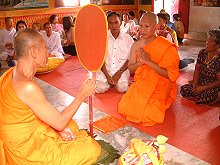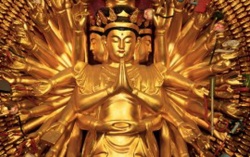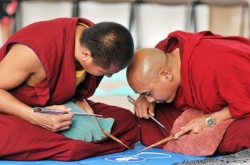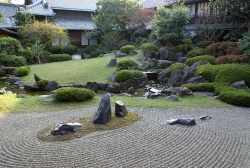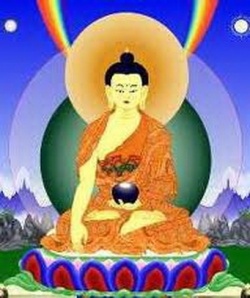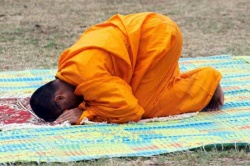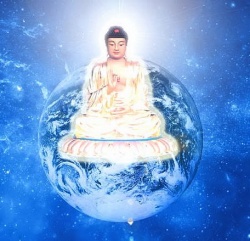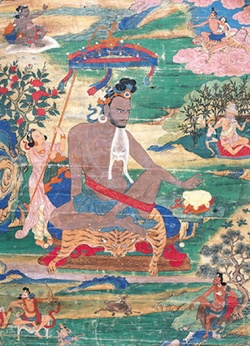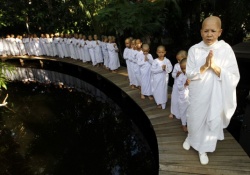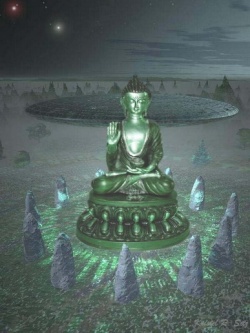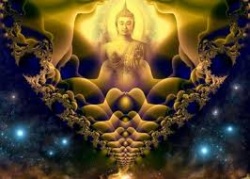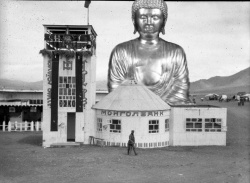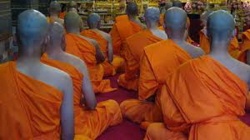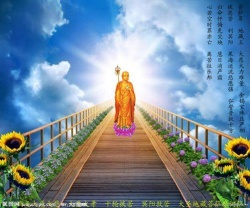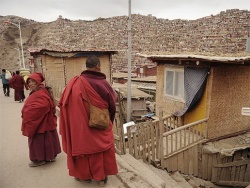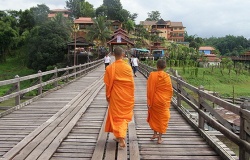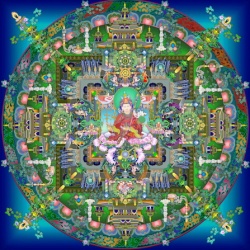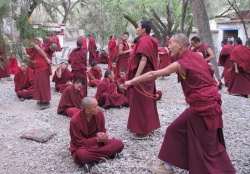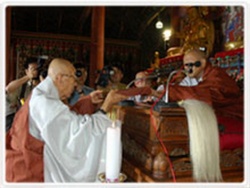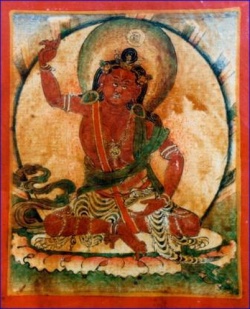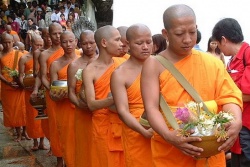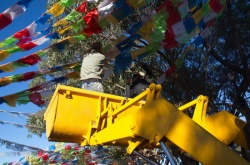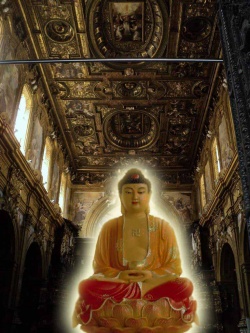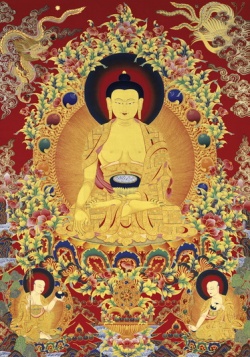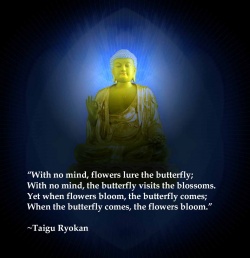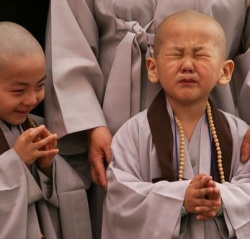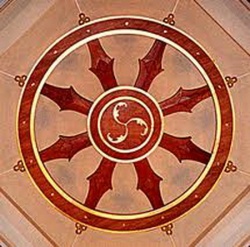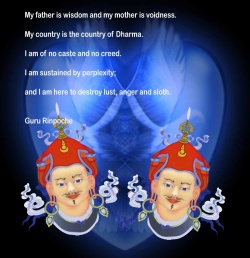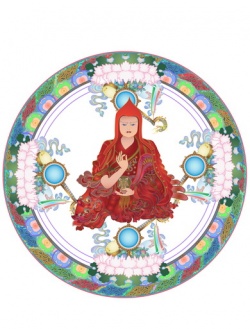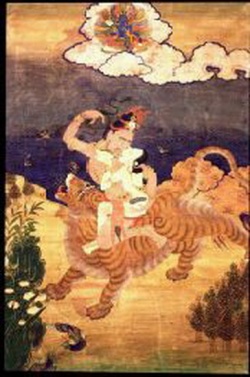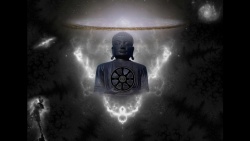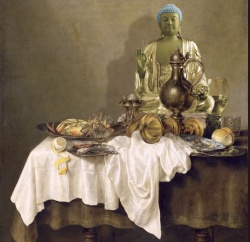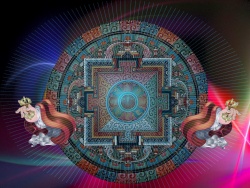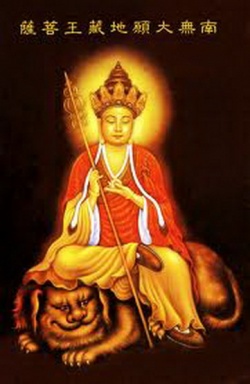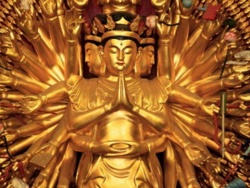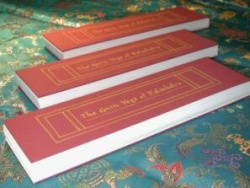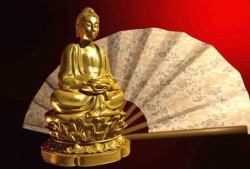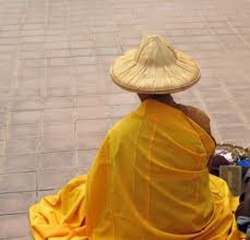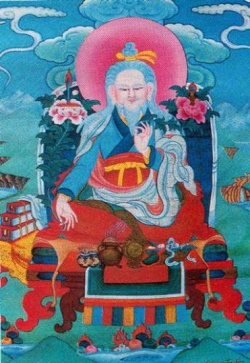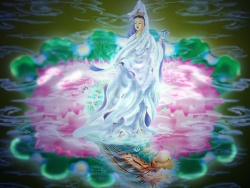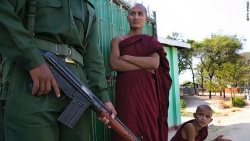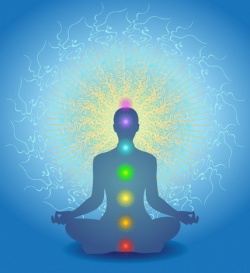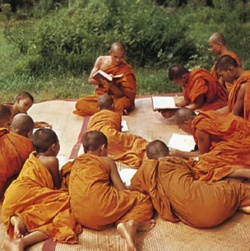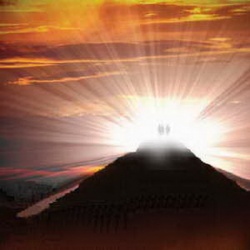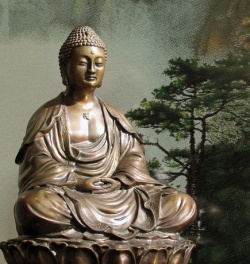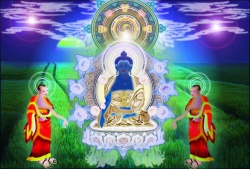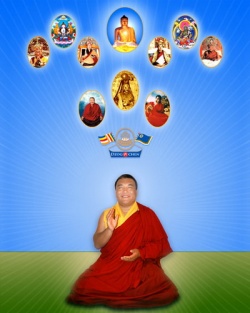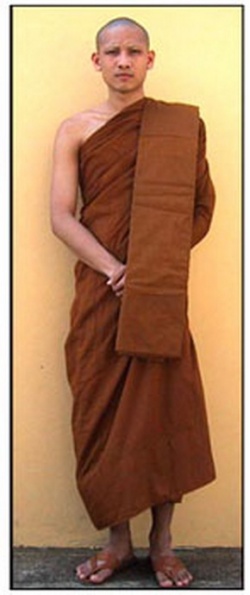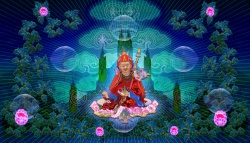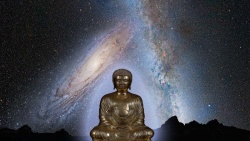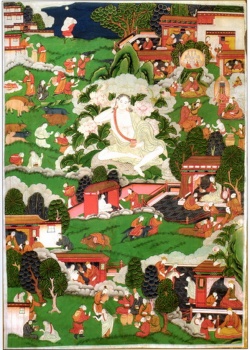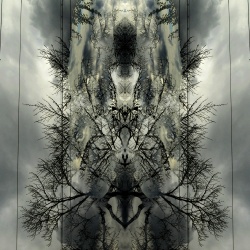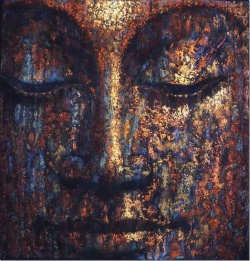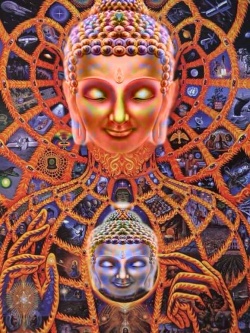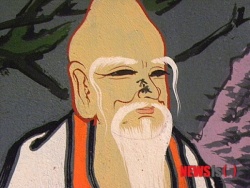Ten Kasiṇa
ten Kasiṇa's mentioned in the Pali Tipitaka:
- earth kasina (paṭhavī Kasiṇa),
- water kasina (āpo Kasiṇa),
- air kasina, wind (vāyo Kasiṇa),
- Fire kasina (tejo Kasiṇa),
- blue kasina, green kasina (nīla Kasiṇa),
- yellow kasina (pīta Kasiṇa),
- red kasina (lohita Kasiṇa),
- white kasina (odāta Kasiṇa),
- enclosed space kasina, hole, aperture (ākāsa Kasiṇa),
- bright Light kasina (ā Loka Kasiṇa).
These, bhikkhus, are the ten kasiṇas bases.
Which ten?
One contemplates the earth kasiṇa, above, below, transversely, undivided, all-permeating;
one contemplates the water kasiṇa, above, below, transversely, undivided, all-permeating;
one contemplates the fire kasiṇa, above, below, transversely, undivided, all-permeating;
one contemplates the air kasiṇa, above, below, transversely, undivided, all-permeating;
one contemplates the blue kasiṇa, above, below, transversely, undivided, all-permeating;
one contemplates the yellow kasiṇa, above, below, transversely, undivided, all-permeating;
one contemplates the red kasiṇa, above, below, transversely, undivided, all-permeating;
one contemplates the white kasiṇa, above, below, transversely, undivided, all-permeating;
one contemplates the space kasiṇa, above, below, transversely, undivided, all-permeating;
one contemplates the consciousness kasiṇa, above, below, transversely, undivided, all-permeating.
These, bhikkhus, are the ten kasiṇas bases.
This is a translation of Pa Auk Sayadaw’s Dhamma talk on MahaAssapura Sutta.
However the chapters ‘The Ten Kasinas’ and ‘The Four Immaterial Jhanas’ are adapted from the book Knowing and Seeing so as to avoid repetition in translation work.
Only a slight editing has been added to these excerpts.
These additions are from the translation of the MahaAssapura Sutta dhamma talk.
The rest of the other chapters are translated directly from the aforesaid Dhamma talk in Burmese.
The style of translation follows the Burmese way of speaking as used during the talk.
The Ten Kasinas
The Colour Kasina
There are four colours used as a basis for kasina meditation and they are blue, yellow, red, and white.
Of these four colours the one translated as blue (nila) can also be translated as black, or brown.
All these four kasinas can be developed by using the colours of different parts of the body.
For example, according to the Abhidhamma commentary, the colour of head hairs, body hairs, and iris of the eyes can be used to develop the blue kasina up to the fourth jhana.
The colour of fat can be used to develop the yellow kasina up to the fourth jhana.
The colour of blood, and flesh can be used to develop the red kasina up to the fourth jhana.
And the white parts of the body such as the bones, teeth, and nails can be used to develop the white kasina up to the fourth jhana.
The White Kasina
It says in the suttas that the white kasina is the best of the four colour kasinas because it makes the mind clear and bright.
For that reason I shall explain how to develop that particular colour kasina first.
To develop the white kasina, you should first re-establish the fourth jhana based on mindfulness-of-breathing.
When the light produced by that concentration is bright, brilliant, and radiant, you should discern the thirty-two parts of the body internally.
Then discern the thirty-two parts of the body externally in a being sitting in front of you or nearby.
Then, of those thirty-two external parts, discern just the skeleton.
If you want to discern that skeleton as repulsive you can do so too, but if you do not wish to, simply discern the skeleton.
Then, having decided which is the whitest place of that skeleton and using that place, or by taking the white of the whole skeleton if the whole skeleton is white, or by taking the back of the skull as object, concentrate on it as ‘white, white’.
Alternatively, if your mind is really sharp and you have concentrated on the internal skeleton as repulsive and reached the first jhana, then see the skeleton as white and use that as your object for preliminary development.
If you are unable or do not want to use the colour of an internal part as a kasina to reach jhana, you should take an external skeleton and use the white of that to continue to develop and meditate on.
You could also discern the repulsiveness in an external skeleton, and develop it by making the perception of that skeleton stable and firm, you make the white of the skeleton more evident.
Having achieved that, instead of continuing to concentrate on the skeleton as repulsive, you could concentrate on it as ‘white, white’, and thus change to the development of the white kasina.
Having taken the white of the external skeleton as object, and concentrating on the white of the skull in particular, you should practice to keep the mind calmly concentrated on that white object for one or two hours at a time.
Because of the assistance and support of the concentration of the fourth jhana based on mindfulness-of-breathing, you will find that your mind will stay calmly concentrated on the object of white.
When you are able to concentrate on the white for one or two hours, you will find that the skeleton disappears and only a white circle remains.
When the white circle is white as cotton wool it is the uggaha-nimitta (taken-up sign).
When it is bright and clear like the morning star it is the patibhaga-nimitta (counterpart sign).
Before the uggaha-nimitta arises, the skeleton nimitta from which it arose, is what is called the parikamma-nimitta (preparatory sign).
If you developed the white kasina in a past life, either during this dispensation or a previous Buddha’s dispensation, that is, if you have white kasina parami, then by just trying, and concentrating on the white circle nimitta, you will be able to attain the patibhaga-nimitta.
If that be the case, you will not need to expand the nimitta, because as you look at it and note it as ‘white, white’, it will automatically expand to fill all ten directions.
Should it happen that the white kasina-nimitta does not automatically expand and spread to fill all ten directions, then just continue to note it as ‘white, white’.
When it is bright white and especially when it is clean and clear, which is the patibhaga-nimitta, then continue until you can enter the first jhana.
You will find, however, that this concentration is not very stable and does not last long.
In order to make the concentration stable and last a long time, it is important to expand the nimitta.
To do this you should concentrate on the white patibhaga-nimitta and develop your concentration so that it stays with that object for one or two hours.
Then you should make a determination in your mind to expand the white circle by one, two, three, or four inches, depending on how much you think you are able to expand it.
You should try to do this and see if you can succeed.
Do not try to expand the nimitta without first determining a measure: make sure to try to expand it by determining a limit of one, two, three, or four inches.
While you are expanding the white circle you may find that it becomes unstable.
Then you will need to go back to noting it as ‘white, white’ to make it stable.
As your concentration increases in strength, you will find that the nimitta becomes stable and calm.
When the expanded nimitta becomes stable you should repeat the process: that is, again determine to expand it by a few inches at a time.
In this way you can expand the nimitta until it is one yard in size, then two yards in size and so on. As you succeed you should go on expanding the nimitta in stages, until it extends in all ten directions around you without limit.
Thus you will reach a stage when wherever you look, you see only the white nimitta.
At this point you will not see even a trace of materiality whether internal or external, but will be aware of only the white kasina.
You should keep your mind calmly concentrated on the white kasina, and when it is stable, then just like hanging a hat on a hook, place your mind on one part of that white kasina, and keep your mind there, and continue to note it as ‘white, white’.
When your mind is calm and stable, the white kasina will also be calm and stable, and it will be exceedingly white, bright, and clear.
This too is a patibhaga-nimitta that has been produced by expanding the original white kasina-nimitta.
You must continue to meditate until you can keep your mind concentrated on that white kasina patibhaga-nimitta continuously for one or two hours.
Then the jhana factors will become very prominent, clear, and strong in your mind.
At that time you will have reached the first jhana.
At that time the five jhana factors will be present:
1. Applied thought (vitakka): directing and placing of the mind on the white kasina patibhaga-nimitta.
2. Sustainthought (vicara): maintaining of the mind on the white kasina patibhaganimitta.
3. Joy (piti): liking for the white kasina patibhaga-nimitta.
4. Bliss (sukha): pleasant feeling or happiness associated with experiencing the white kasina patibhaga-nimitta.
5. One-pointedness (ekaggata): one-pointedness of mind on the white kasina patibhaganimitta.
Each of the individual factors of jhana on its own is called a jhana factor, but when they are taken together they are called jhana.
Practice until you have attained the five masteries of the first white kasinajhana.
Then, when you have attained mastery of the first jhana, develop the second, third, and fourth jhana in the way I described in my talk on mindfulness-of-breathing.
The four jhanas are also called ]]fine-material-plane jhanas)], (rupavacara-jhana), because they are capable of producing rebirth in the fine-material realm.
But here we do not encourage the development of jhanas for the sake of attaining rebirth in the fine-material realm, but for the sake of using them as a basis for developing Vipassana meditation
The meditator now has attained the 4th Jhana of White Kasina. Having attained the 4th Jhana, what was further taught (in MahaAssapura Sutta) by the Buddha?
taught the following:
So evam samahite citte parisuddhe pariyodate anavgane vigatupakkilese mudubhute kammaniye thite aneñjappatte pubbenivasanussatiñanaya cittam abhininnameti.
(Majjhima Nikaya)-with his mind thus composed,
pure (parisuddha),
brilliantly bright (pariyodata),
free from defilements (vigatupakkilesa),
pliant (mudubhuta), adaptable (Kammaniya),
stable (thita), unshakable (aneñjappatta),
he inclines the mind to the knowledge of the Recollection of Past Lives.
Here, the Buddha taught the Abhiñña of Recollection of Past Lives as the 11th cause for one to be called a ‘monk’, a ‘Samana’.
Then one may ask, “Is it so that only when one has achieved this Abhiñña that one can be called a ‘monk’?”
It does not mean like that.
This Sutta was taught for the sake of the Tevijja Patta Arahants.
But if a person is a Sukkha Vipassana person then he can attain Arahant by Upacara Samadhi (neighbourhood Concentration) only, without attaining any Jhana Concentration. At that time the Buddha was not teaching this way of practice.
He was teaching the way of Tevijja Patta Arahants.
Once there was a question asked as to whether the discernment of past life arise spontaneously or the meditator has to incline his mind towards the past.
Here, which word did the Buddha used at the end? Cittam abhininnameti, the mind inclines to discern the past.
Whatever one wants to know then one tries to discern it.
It does not have the nature of arising spontaneously. Paramattha Dhamma (ultimate reality) does not arise spontaneously.
Its nature is to arise only when there is a cause.
Here the Buddha taught about the Recollection of Past Lives Abhiñña.
Then, one may ask that, if the meditator attains up till the 4th Jhana of White Kasina only, can he achieve the Abhiñña of Recollection of Past Lives?
He cannot achieve it yet.
The 4th Jhana mentioned by the Buddha here refers to the 4th Jhana which is the basis/foundation (padaka) of Abhiñña.
Then, when does a 4th Jhana becomes a basis of Abhiñña?
To understand better, one should know that there are 8 Kasina:
Red Kasina and
One should be able to attain at least the 8 Samapatti (i.e. 4 Rupa Jhana and 4 Arupa Jhanas) of each Kasina.
After that the meditator must practice to be skilful in the 8 Kasina and 8 Samapatti by the [[14 masteri.
Being thus skilful, if he wants to achieve the Abhiñña, – as he now has mastery over his mind very well – then he enters again into the relevant 4th Jhana.
That 4th Jhana is called the 4th Jhana basis of Abhiñña.
This is the type of Jhana mentioned here.
Therefore, before this stage the meditator has to practise the 8 Kasina and the 8 Samapatti; and then to train the mind by the 14 masteries.
The following are the practice of the other remaining Kasina.
If you have been able to develop the white kasina meditation up to the fourth jhana by using the white colour of external bones, then, in a similar way, you will be able to develop the brown (or blue) kasina based on external head hairs, the yellow kasina based on external fat or urine, and the red kasina based on external blood.
You can, in the same way, also practice colour kasina based on internal parts of your body Now, I would like to explain how to develop the remaining six types of kasina.
The Earth Kasina
To develop the earth kasina you should find an area of plain earth, which is reddish brown like the sky at dawn, is free from sticks, stones, and leaves, and then with a stick or some other instrument draw a circle about one foot across.
Then you should concentrate on that circle of earth, and note it as ‘earth, earth’.
You should concentrate on that circle of earth with your eyes open for a while, and then close your eyes, and see if you can visualize the circle of earth.
If you are unable to visualize the sign in this way, you should re-establish your concentration based on mindfulness-of-breathing, or on the white kasina, up to the fourth jhana.
Then with the assistance of your light of concentration you should look at that circle of earth.
When you can see the nimitta of that circle of earth as clearly as if you were looking at it with your eyes open, you can go somewhere else to develop the nimitta.
You should not concentrate on the colour of the earth nimitta, or the characteristics of hardness, roughness etc. of the earth-element, but just keep your mind concentrated on the concept of earth.
You should continue to develop this learning sign until you are able to remove the five hindrances, and attain access concentration at which time the nimitta will become the patibhaga-nimitta, and be exceedingly pure and clear.
You should then expand the size of that patibhaga-nimitta a little at a time until it fills all ten directions, and then develop concentration on it up to the fourth jhana.
The Water Kasina
To develop the water kasina you should use a bowl, or bucket of pure, clear water, or a well of clear water.
Then concentrate on that water as ‘water, water’ until you have developed the uggaha-nimitta.
Then develop this sign in the same way as you did for the earth kasina.
The Fire Kasina
To develop the fire kasina you should use the flames of a fire, a candle, or any other flames that you remember seeing before.
If that is too difficult, you can make a screen with a circular hole in it about one foot across.
Put the screen in front of a wood- or grass-fire in such a way that you see only the flames through the hole.
Without concentrating on the smoke, or the burning wood or grass, concentrate on the concept of fire and note it as ‘fire, fire’.
Then develop the uggaha-nimitta in the same way.
The Wind Kasina
The wind kasina can be developed through the sense of touch, or of sight.
Through the sense of touch you should be mindful of the wind as it comes in through a window or door, and brushes against the body, and note it as ‘wind, wind’.
Through the sense of sight you should be mindful of the movement of leaves or branches of trees in the wind, and note it as ‘wind, wind’.
You can do this by developing concentration up to the fourth jhana using another kasina object, and then using your light of concentration see this movement externally, and discern the nimitta of the wind.
The uggaha-nimitta looks like steam coming off hot milk rice, but the patibhaganimitta is motionless.
The Light Kasina
The light kasina can be developed by looking at the rays of light as they stream into a room through a crack in the wall and fall on the floor, or as they stream through the leaves of a tree and fall on the earth, or by looking up through the branches of a tree at the light in the sky above.
If that is too difficult, you can get an earthen pot and place a candle or a lamp inside it, and place the pot in such a way that rays of light come out of the opening of the pot and fall upon a wall.
Then concentrate on the circle of light on the wall as ‘light, light’.
The Space Kasina
The space kasina can be developed by looking at the space in a doorway, window, or keyhole.
If that is too difficult, you can make a piece of board with a circular hole in it about eight inches to one foot across.
Hold the board up in such a way that you can see only the sky through the hole, no trees or other objects.
Then concentrate on the space within that circle and note it as ‘space, space’
The Four Immaterial Jhanas
Once you have attained the four jhanas with each of the ten kasinas you can proceed to develop the four immaterial jhanas (arupa-jhana) called the four immaterial states.
The four immaterial states are:
1. The Base-of-Boundless-Space,
2. The Base-of-Boundless-Consciousness
3. The Base-of-Nothingness,
4. The Base of Neither-Perception-Nor-Non-Perception.
You should develop the four immaterial jhanas only after you have developed all ten kasinas up to the fourth jhana.
You can develop the four immaterial jhanas based on any of the nine kasinas, and not the space kasina.
The Base-of-Boundless-Space
To develop the four immaterial jhanas you should first reflect upon the disadvantages of materiality.
The human body produced by the sperm and egg of your parents is called the produced-body (karajakaya).
Because you have a produced-body, you are subject to assault with weapons such as knives, spears, and bullets, and you are subject to being beaten, struck, and tortured.
The produced body is also subject to many different kinds of disease such as diseases of the eyes, ears, and heart.
So you should first understand by wisdom that because you have a produced body, made of materiality, you are subject to various kinds of suffering, and that if you can be free of materiality, you can also be free of the suffering dependent upon that materiality.
Even though the fourth jhana based on a kasina surpasses gross physical materiality, you still need to surmount the kasina materiality, since it is the counterpart of gross physical materiality.
Having considered this and having become dispassionate towards the kasina materiality, you should develop one of the nine kasinas, such as the earth kasina, and use it to develop the fine-material jhana (rupa-jhana), up to the fourth jhana.
After emerging from the fourth fine-material jhana based on one of the nine kasina, such as the earth kasina, you should reflect on the disadvantages of the jhana based on materiality, namely that:
1. The fourth jhana has as its object kasina materiality towards which I have become dispassionate.
2. The fourth jhana has joy of the third jhana as its near enemy.
3. The fourth jhana is grosser than the four immaterial jhanas.
Since the mental formations present in the fourth jhana are the same as the mental formations in the four immaterial jhanas, you do not need to reflect on any of their disadvantages, as you did when developing the four fine-material jhanas.
Having seen the disadvantages of, and become dispassionate towards the fourth finematerial jhana, you should reflect on the advantages of the immaterial jhanas as being more peaceful.
Then you need to expand your nimitta, say, of the earth kasina, so that it is infinite, or as large as you wish, and then remove the kasina materiality by concentrating on the space occupied by the kasina materiality as ‘space, space’ or ‘boundless space, boundless space’.
Then what remains is the space left behind after the removal of the kasina, in other words, the space which the kasina formerly occupied.
If that is too difficult, you should try to discern space in one part of the earth kasinanimitta.
When you can see a space in the earth kasina-nimitta, you should emphasize only on the space and expand it up to the infinite universe.
As a result, the entire earth kasina-nimitta is replaced by the space.
You need to continue concentrating on that sign of space as ‘space, space’ with applied thought.
By doing this again and again you will find that the hindrances are suppressed and that with the sign of space as object you reach access concentration.
By concentrating repeatedly on that sign you will find that with the sign of space as object you reach jhana.
This is the first immaterial jhana called the base-of-boundless-space.
The Base-of-Boundless-Consciousness
The second immaterial jhana is the base-of-boundless-consciousness and it has as its object the base-of-boundless-space jhana-consciousness (akasanabcayatana-jhana-citta), which had boundless space as its object.
If you wish to develop the base-of-boundless-consciousness, you must first attain the five masteries of the base-of-boundless-space.
After that, you should reflect on the disadvantages of the base-of-boundless-space, and consider that it has the fourth fine-material jhana as its near enemy.
Then consider that it is not as peaceful as the base-of-boundless-consciousness.
Having seen the disadvantages of, and become dispassionate towards the base-ofboundless- space, you should reflect on the peaceful nature of the base-of-boundlessconsciousness.
Then you should concentrate on the consciousness that was present during the attainment of the base-of-boundless-space, the consciousness which had boundless space as its object.
You should concentrate again and again on that consciousness and note it as ‘consciousness, consciousness’.
You should not just note it as ‘boundless, boundless,’ but note it as ‘boundless consciousness, boundless consciousness’ or just ‘consciousness, consciousness’.
You need to continue concentrating on that sign as ‘consciousness, consciousness’ with applied thought. By doing this again and again you will find that the hindrances are suppressed, and that access concentration arises with that sign as its object. By repeated attention to that sign you will find that absorption jhana arises with that sign as its object. This is then the second immaterial jhana called the base-of-boundless-consciousness.
The Base-of-Nothingness
The third immaterial jhana is the base-of-nothingness.
It has as its object the absence of the consciousness which took boundless space as its object. That consciousness had been taken as the object of the base-of-boundless-consciousness.
If you wish to develop the base-of-nothingness, you must first attain the five masteries of the base-of-boundless-consciousness.
After that, you should reflect on the disadvantages of the base-of-boundless-consciousness, namely that: the base-of-boundless-consciousness has the base of- boundless-space as its near enemy and it is not as peaceful as the base-of-nothingness.
Having seen the disadvantages of, and become dispassionate towards the base-of boundless-consciousness, you should reflect on the peaceful nature of the base-of-nothingness.
Then you should concentrate on the absence of the consciousness that took boundless space as its object.
In this case there are two types of consciousness: the base-of-boundless-space jhana-consciousness (akasanabcayatana-jhana-citta) and the base-of-boundless-consciousness jhana-consciousness (vibba-nabcayatana-jhana-citta).
Two consciousnesses cannot arise in one mind-moment.
When the base-of-boundless-space jhana-consciousness is present as ‘arising static-passing-away’, the base-of-boundless-consciousness jhana-consciousness cannot be present as ‘arising-static-passing-away’.
In the same way, when the base-of-boundless-consciousness jhana-consciousness is present, the base-of-boundless-space jhana-consciousness cannot be present either.
It is the absence of the base-of-boundless-space jhana-consciousness which we must take as object.
Taking the absence of thebase-of-boundless-space jhana-consciousness as object, note it as ‘nothingness, nothingness...’ or ‘absence, absence...’.
You need to continue concentrating on that sign as ‘nothingness, nothingness’ with applied thought. By doing this again and again you will find that the hindrances are suppressed, and that access concentration arises with that sign as its object. By repeated attention to that sign you will find that absorption jhana arises with that sign as its object. This is then the thirdimmaterial jhana called the base-of-nothingness.
The Base of Neither-Perception-Nor-Non-Perception
The fourth immateria jhana is the base of neither-perception-nor-non-perception, and it has as its object the consciousness present during the attainment of the base-of-nothingness. It is called the base of neither-perception-nor-non-perception because the perception present in it is extremely subtle.
If you wish to develop the base of neither-perception-nor-non-perception, you must first attain the five masteries of the base-of-nothingness. After that you should reflect on the disadvantages of the base-of-nothingness, namely that: the base-of-nothingness has the base-ofboundless- consciousness as its near enemy, and it is not as peaceful as the base of neither perception- nor-non-perception. Furthermore, perception is a disease, perception is a boil, perception is a dart, the base of neither-perception-nor-non-perception is peaceful.
Having seen the disadvantages of, and become dispassionate towards the base-ofnothingness, you should reflect on the peaceful nature of the base of neither-perception-nor-nonperception.
Then you should concentrate again and again on the base-of-nothingness jhanaconsciousness as ‘peaceful, peaceful’.
You need to continue concentrating on the sign of the base-of-nothingness jhanaconsciousness as ‘peaceful, peaceful’ with applied thought.
By doing this again and again you will find that the hindrances are suppressed, and that access concentration arises with that sign as its object.
By repeated attention to that sign you will find that absorption jhana arises with that sign as its object.
This is then the fourth immaterial jhana called the base of neither-perceptionnor- non-perception.
The 14 Masteries
The 8 Samapatti are explained here briefly only.
That is, from the 1st Jhana till the Neva Sañña Na Saññayatana Jhana there are 8 attainments (Samapatti).
However one is still not able to change to practice the Abiññana yet.
He still has to train his mind in the 14 masteries (see below) skilfully.
However before he practices the 14 masteries the meditator has to practice and attain as mentioned above, from the 1st Jhana until NevaSaññaNaSaññayatana Jhana based on each Kasina.
Let’s take for example that the meditator has attained all the 8 Samapatti based Earth (Pathavi Kasina.
Then he must similarly practice to attain them based on Water (Apo Kasina.
It has already been explained previously on the attainment of 1st to 4th Jhana in Water Kasina. At that stage the Water Kasina is already expanded to the end of the universe or to the infinite universe. Then without paying attention on the Water Kasina, pay attention only on the space (Akasa) at the place where the Water Kasina touches. If the meditator is not successful in practising thus, then if he shines by his light at the middle of the Water Kasina, he will find the space (Akasa) there. Then, paying attention only on the space, the Water Kasina is removed.
Only the space (Akasa) will widen gradually. In this way practise Akasanañcayatana Jhana, Viññanañcayatana Jhana, Akiñcaññayatana Jhana and NevaSaññaNaSaññayatana Jhana stage by stage successively. This is the practise to acquire control or mastery over the mind.
The next one is Tejo Kasina (Fire Kasina). Having attained the 4th Jhana of Fire Kasina one can continue to attain all 8 Samapatti based on it successively. In the same way the meditator has to practise to attain the 8 Samapatti based on the other Kasina also, which are;
Wind Kasina (Vayo), and the colour kasinas:
Brown Kasina (Nila),
Red Kasina (Lohita) and
The attainment of these 8 Kasina (ie including Earth and Water Kasina just mentioned) are necessary to achieve the Abhiñña.
However one can also practise to attain the 8 Samapatti by the remaining 2 other Kasina: Light (Aloka) and Space (Akasa) Kasina.
Light Kasina is important for the achievement of Divine Eye (Dibba Cakkhu Abhiñña). Therefore in the same way as above, practise to attain the 8 Samapatti by these 2 remaining Kasina.
The meditator at this stage has already practised the 8 Samapatti of each of the 10 Kasina.
For those who want to achieve the Abhiñña must practise these 10 Kasina in 8 Samapatti proficiently.
He must practise the 14 masteries to be able to have mastery over the mind. There are 8 Kasina from Earth (Pathavi) Kasina to White (Odata) Kasina.
There are also the 8 Samapatti based on each of these Kasina.
One must practise the 8 Kasina and 8 Samapatti in 14 masteries (1) Kasinanuloma:
The first one is Kasinanuloma practising the kasina in the right order. The meditator enters into all the 8 Samapatti successively based on Earth Kasina.
After that he enters into each of the8 Samapatti successively by Water Kasina. Then in the same way followed by the other Kasina in the right order.
That is to say he enters into each of the 8 Samapatti of
Red Kasina and
White Kasina in order, without skipping the Kasinas.
He must remember the order carefully. It is mentioned that the meditator should practise in this order for a hundred times, a thousand times. (Vism. XII,3)
Kasinapatiloma
This is practising the Kasina in reverse order.
White kasina is the last kasina in series. But now begin by entering into each of the 8 Samapatti successively based on White Kasina first. After that enter into each of the 8 Samapatti based on Red Kasina; followed by Yellow Kasina, Brown Kasina, Wind Kasina, Fire Kasina, Water Kasina and Earth Kasina. Practise in this reverse order as many times as 100 times, 1000 times.
Kasinanuloma patiloma
This is practising the Kasina in forward and reverse order. The meditator first enter into all the 8 Samapatti from Earth Kasina to White Kasina successively. Then he enters it from White Kasina to Earth Kasina in reverse order. He practises in this forward order and then reverse order many times.
Jhananuloma
This is practising the Jhana in forward order. Say, in Earth Kasina enter into the 1st Jhana; after that 2nd Jhana, then 3rd Jhana, then 4th Jhana, then Akasanañcayatana Jhana, then Viññanañcayatana Jhana, then Akiñcaññayatana Jhana, and then NevaSaññaNaSaññayatana Jhana. Enter into the 8 Samapatti successively in Earth Kasina. Practise in the same way for all the other remaining Kasina.
Jhanapatiloma
This is practising the Jhana in reverse order. In this case, for example in Earth Kasina he does not begin with 1st Jhana as before. He begins by entering into the NevaSaññaNaSaññayatana Jhana first.
After that he enters into its Akiñcaññayatana Jhana; after that, Viññanañcayatana Jhana; then Akasanañcayatana Jhana; after that he enters into the Rupavacara 4th Jhana; then 3rd Jhana; then 2nd Jhana; then 1st Jhana.
Thus he practises in reverse order. If he is not able to practise in this way, then how should he do? He should practrise from the beginning again. Practise thoroughly & successively.
Enter into the Earth Kasina Jhana from its 1st Jhana till its NevaSaññaNaSaññayatana Jhana successively, again & again.
When the momentum of the practice becomes powerful, then pick up the NevaSaññaNaSaññayatana Jhana again from there; after that descend to the other Jhana in reverse order. One can practise in this way.
Practise in the same way as in Earth Kasina for the other remaining seven Kasina.
If successful then change to the next one.
Jhananulomapatiloma
This is practising the Jhana in forward and reverse order.
Let's say in Earth Kasina the meditator enters into its Jhana from 1st Jhana to NevaSaññaNaSaññayatana Jhana successively first.
Then he enters from its NevaSaññaNaSaññayatana Jhana till its 1st Jhana in reverse order.
The meditator practise in this forward order and then reverse order of the Jhana in each of the 8 Kasina again and again.
Jhanukkantika
- This is to practise by skipping the Jhana; that is skipping every other Jhana in the Jhana sequence. For example, in the Earth Kasina enter into its 1st Jhana.
Without entering into the 2nd Jhana, that is skipping the 2nd Jhana, enter into the 3rd Jhana. Then do not enter into the 4th Jhana.
Skipping the 4th Jhana, enter into its Akasanañcayatana Jhana.
It is the space (Akasa) of the Earth Kasina.
After Akasanañcayatana Jhana, leave aside the Viññanañcayatana Jhana.
Continue by entering into its Akiñcaññayatana Jhana.
Altogether, he has now entered into 4 of the Jhana.
After that, "pick up" the Earth Kasina again and enter into its 2nd Jhana, followed by 4th Jhana; then its Viññanañcayatana Jhana; and then its NevaSaññaNaSaññayatana Jhana.
Practise in this way of skipping every other Jhana again and again.
If one is successful in Earth Kasina then change to practise in the same way with the other remaining seven Kasina, beginning with Water Kasina. Practise again & again.
Kasinukkantika
- This is to practise by skipping the Kasina. The meditator enters into the 1st Jhana of Earth Kasina.
After that, leaving aside or skipping Water Kasina, he enters into the 1st Jhana of Fire Kasina, followed by the 1st Jhana of Brown Kasina; then 1st Jhana of Red Kasina.
If successful by these 4 Kasina, then again he enters into the 1st Jhana but of Water Kasina, followed by 1st Jhana of Wind Kasina; then 1st Jhana of Yellow Kasina;
and then 1st Jhana of White Kasina. In the same way as entering into the 1st Jhana by skipping the Kasina, he practises the 2nd Jhana by skipping the Kasina.
Also, he practises similarly in 3rd Jhana, 4th Jhana, Akasanañcayatana Jhana, Viññanañcayatana Jhana, Akiñcaññayatana Jhana, and NevaSaññaNaSaññayatana Jhana. He enters into the Jhanas by skipping the Kasina. Practise this again and again.
Jhanakasinukkantika
This is to practise by skipping both Jhana and Kasina. For example, firstly enter into the 1st Jhana of Earth Kasina.
After emerging from this 1st Jhana, enter into the 3rd Jhana of Fire Kasina, skipping Water Kasina.
Then enter into the Akasanañcayatana Jhana, having removed the conceptualized Brown Kasina.
Then in Red Kasina, enter into its Akiñcaññayatana Jhana. This is skipping both Jhana and Kasina.
After skipping like that, begin another round by firstly entering into the 2nd Jhana of Water Kasina, followed by 4th Jhana of Wind Kasina; then Viññanañcayatana Jhana Jhana of Yellow Kasina;
and then NevaSaññaNaSaññayatana Jhana based on White Kasina. Skipping both Jhana and Kasina.
In the same way, one can practise another different round again if he is able to.
For example, enter into the 2nd Jhana of Earth Kasina, followed by 4th Jhana of Fire Kasina; then Viññanañcayatana Jhana based on Brown Kasina; and then NevaSaññaNaSaññayatana Jhana based on Red Kasina.
After this, the next round is to enter into the 1st Jhana of Water Kasina, followed by the 3rd Jhana of Wind Kasina;
then Akasanañcayatana Jhana based on Yellow Kasina; and then Akincaññayatana Jhana based on White Kasina. Practise the skipping of both Jhana and Kasina again and again.
Avgasavkantika
This is the practice of changing the Jhana factors. It means the technique of mainly paying attention on the changing of the Jhana.
For example in Earth Kasina, enter into its 1st Jhana, and then 2nd Jhana.
The way here is to notice the changing of the Jhana factors. Enter into the rest of the 8 Samapatti for Earth Kasina. It is the same for the other Kasina also.
Arammana savkantika
It is the practice of changing the Kasina object. Enter into the 1st Jhana of Earth Kasina;
after that enter into 1st Jhana of Water Kasina; then 1st Jhana of Fire Kasina; then 1st Jhana of Wind Kasina, Brown Kasina, Yellow Kasina, Red Kasina, White Kasina one after the other successively.
Only the Kasina object is changed each time but the Jhana does not change.
In the same way enter into the 2nd Jhana of Earth Kasina, Water Kasina, Fire Kasina, Wind Kasina, Brown Kasina, Yellow Kasina, Red Kasina and White Kasina one after the other, successively.
Practise similarly in 3rd Jhana for all 8 Kasina; in 4th Jhana for all 8 Kasina;
in Akasanañcayatana Jhana for all 8 Kasina; in Viññanaññcayatana Jhana for all 8 Kasina;
in Akincaññayatana Jhana for all 8 Kasina; in NevaSaññaNaSaññayatana Jhana for all 8 Kasina.
At each time, only the Kasina object is changed; the Jhana does not change.
Avgarammanasavkantika
This is the practise of changing both the Jhana factor and Kasina object. Enter into the 1st Jhana of Earth Kasina.
After that enter into the 2nd Jhana of Water Kasina; followed by 3rd Jhana of Fire Kasina; then 4th Jhana of Wind Kasina; then Akasanañcayatana Jhana based on Brown Kasina;
then Viññanañcayatana Jhana based on Yellow Kasina;
then Akincaññayatana Jhana based on [[Red[Kasina]]; then NevaSaññaNaSaññayatana Jhana based on White Kasina. This is the changing of both the Jhana factor and Kasina object.
(===Avgavavatthapana===
This is defining the Jhana factors.
Enter into the 1st Jhana of Earth Kasina. After that discern and define the 5 factors of the Jhana.
Then enter into the 2nd Jhana.
After that define the 2nd Jhana factors which are joy (piti), happiness (sukha) and onepointedness (ekaggata).
Then enter into the 3rd Jhana and after that define its 2 Jhana factors: happiness (sukha) and one pointedness (ekaggata).
Then enter into the 4th Jhana and after that define its 2 Jhana factors: equanimity (upekkha) and one pointedness(ekaggata).
Then enter into Akasanañcayatana Jhana, Viññanañcayatana Jhana, Akincaññayatana Jhana and NevaSaññaNaSaññayatana Jhana successively and at each time define the 2 Jhana factors (equanimity and one pointedness) which is present in all the 4 Arupa Jhana.
Having entered into these Jhana, the meditator must define the Jhana factors after emerging from each respective Jhana. It is the same for the remaining other Kasina.
(14) Arammanavavatthapana: This is defining the Kasina object. Enter into the 1st Jhana of Earth Kasina.
After that define its object as "This is Earth Kasina". Similarly enter into its 2nd Jhana, 3rd Jhana, 4th Jhana, Akasanañcayatana Jhana, Viññanañcayatana Jhana, Akincaññayatana Jhana and NevaSaññaNaSaññayatana Jhana successively.
At each time define its object after emerging from the Jhana.
After that enter into the 8 Samapatti similarly for the remaining Kasina, from Water Kasina to White Kasina.
At each time, after emerging from the respective Jhana, define the Kasina object on which one is meditating then.
Now, the 14 ways of mastery are completed. In this monastery, these 14 ways of practice are taught to the meditator only after he has realized the Peaceful Element, having meditated on these Jhana Samapatti by the 2 methods of Vipassana meditation:
Anupada Dhamma Vipassana and Kalapa Sammasana
Why is this so? Due to the power of the Samapatti (i.e. the Concentration), the Vipassana nana (insight Knowledge) becomes sharp. Also, because of the power of Vipassana nana, the Samapatti becomes more stable.
If the Samapatti are not "fasten" by the Vipassanana then sometimes these Jhana Samapatti can decline.
The concentration may be ruined. The meaning of Anupada Dhamma Vipassana is as follows: Let us say in Earth Kasina, one enters into its 1st Jhana.
To enumerate the 1st Jhana mental factors there are 34 of them. Meditate Vipassana on each of these 34 mental factors one by one.
For example "Consciousness (Citta), arising and passing away, Anicca","Contact(Phassa), arising and passing away, Anicca" etc.etc. Feeling (vedana),.
Meditating on the three characteristic of Anicca, Dukkha, Anatta (impermanent, suffering, non-self) of each individual mental factor is called Anupada Dhamma Vipassana method.
If the insight becomes sharp and if changing to the insight at passing away only stage, then meditating only on the perishing away of each mental factors as Anicec, Dukkha, Anatta is also called Anupada Vipassana.
It is the same for the remaining Jhanas and Kasinas.
Then, not meditating on the mental factors individually but by meditating on the 34 mental factors (of 1st Jhana) collectively as Anicca, their nature of arising and passing away; as Dukkha, their nature of being constantly oppressed by arising and passing away; as ,Anatta, having no soul, no indestructible essence is called Kalapa Sammasana Vipassana method or Neyya Vipassana method.
It is found that it is easy to teach (the 14 ways) to the meditator who has meditated on the 3 characteristic (Anicca Dukkha Anatta) of the 8 Samapatti by the Anupada Dhamma Vipassana and Kalapa Sammasana Vipassana methods thoroughly.
However it does not mean that it is not easy for the meditator who has not attained the Vipassana insight yet.
There may be some who find it easy, depending on their Parami past perfection).
But, accordingly to the Commentary, generally only one in a hundred or a thousand may be successful.
Just a few of them who have attained Jhanas only is able to change to practise the Abhiñña.
However from the practical research on the meditators, when teaching it to those whose Vipassana insight is matured there are many who can achieve it.
There is difference only in the sharpness of their knowledge.
Therefore, as I have just mentioned, it is a proof that Vipassana insight can make the Samapatti more stable.
Recollection of Past Lives Abhiñña
After training the mind by these 14 ways the meditator can change to the Pychic Powers. However it is mentioned that before that one should practise these 14 ways for a hundred times, a thousand times, for many times.
Having gained mastery over the mind by these 14 ways, what should the meditator further do? In the Maha Assapura Sutta the Buddha taught the 11th cause for one to be called a Samana (i.e. a monk):
So evam samahite citte parisuddhe pariyodate anavgane vigatupakkilese mudubhute kammaniye thite aneñjappatte pubbenivasanussatiñanaya cittam abhininnameti.(Majjhima Nikaya)
The meditator who is going to change to the Abhiñña must enter into the 4th Jhana again after practising the 14 ways of mastery.
A piece of gold which is purified is adaptable or workable. It is ready to be shaped into the various ornaments.
Similarly the mind that has been well trained by the 14 way (and after it has re-entered into the 4th Jhana as the Basis Jhana ) is pure (parisuddha), brilliantly bright (pariyodata) free from lust (anavgana),
free from defilements (vigatupakkilesa), pliant (mudubhuta), adaptable (Kammaniya-it mean that if he wishes to practise the Recollection of Past Lives Abhiñña, it is easy;
if he wishes to practise the Divine Eye Abhiñña, it is easy; if he wishes to practise Vipassana meditation then it is easy.
The mind is adaptable to the various meditation), stable (thita), unshakable (aneñjappatta).
The mind is stable and firm on the object of meditation. Other objects cannot come in. The meditator has mastery over the mind.
Then he inclines the mind to the [[knowledge of the Recollection of Past Lives (Pubbenivasanussati ñana).
That monk (i.e. the meditator) discerns many past lives by his insight.
That is, (recollecting) one live, two lives, three lives, four lives, five lives, ten lives, twenty lives, thirty lives, forty lives, fifty lives, a hundred lives, a thousand lives, a hundred thousand lives, many Samvatta Kappa, many Vivatta Kappa. If he discerns a past live then he knows exactly the following concerning that past live:
1) Evam Namo - the name he was called in that live
2) Evam Gotto - the clan or race then; whether he was a Chinese or Indian or Burmese in that live.
3) Evam Vanno - the complexion then; whether he was handsome or not in that live
4) Evamaharo - the kind of food eaten in that live
5) Evam sukhadukkhappatisamvedi-both the happy and painful experience in that live.
6) Evamayupariyanto - the life span in that life.
He then discerns that having passed away in that past live he was reborn in another past existence. He can also discern the name, clan, complexion, etc…of that past existence.
He can discern like that from one past live to another; one after another.
The destruction of a world cycle and the arising of a world cycle (Samvatta Kappa and Vivatta Kappa) can also be discerned by him.
He knows the destruction, then arising, then continuance, then destruction of world cycles.
The meditator can discern how a world cycle comes to exist by Recollection of Past Lives.
This is a Sutta where the Buddha taught that a disciple of the Buddha (Savaka) can attain Recollection of Past Lives by teaching it as the 11th cause for one to be called a 'monk', a samana. Then the Buddha further taught about it by mentioning a parable.
A man goes from his own village to a second village; then from that second village he goes to a third village; then from the third village he returns to his own village.
Then it may occur in his thoughts that "I went from my own village to the second village.
In that second village I stood in such a way, sat in such a way, spoke in such a way, became silent in such a way. And from that second village I went to the third village.
In that third village I stood in such a way, sat in such a way, spoke in such a way, became silent in such a way.
Then I return from that 3rd village to my own village."
When he reflects like this does it not arise in sequence? It does. In the same (as the parable) the Buddha taught that the meditator discerns manifold past lives by his insight.
How many kind of person can discern past live? (Vism. XIII, 15)
There are 6 kinds of persons who can discern past lives which are:
1)Titthiya-other sectarians
2)Pakati Savaka- ordinary disciple of the Buddha
3)Maha Savaka- great disciple
4)Agga Savaka- eminent disciple
6)Buddha
There are 3 kinds of disciple (Savaka).
The eminent disciple (Agga Savaka) for this Sasana (Buddha's teachings) is Venerable Sariputta and Venerable Maha Moggallana. Only two.
For this sasana also there are 80 great disciples such as Venerable Ananda, Venerable Maha Kassapa, Ven. Maha Kaccana etc.., including Ven. Sariputta and Ven.Maha Moggallana each of whom are entitled foremost in their own qualities.
Excluding the eminent disciples and great disciple, the remaining other disciples are called ordinary disciples.
Titthiya are those who adopt non-Sasana teachings.
There are people who adopt non-Buddhist teachings and have Jhana and Abhiñña.
It is also mentioned in the Text.
There is a reason to mention them. If even those of other sectarians (Titthiya) can attain Jhana and Abhiñña then how can one say that in the Buddha Sasana, where there is a systematic method of practice, Jhana and Abhiñña cannot be achieved (if one trains and practise towards it)?
If the way of practise is correct one can achieve it according to the Parami. It depends on the Parami.
If a meditator has the Parami and the way of practice is correct then we cannot say that he cannot achieve it. (Vism. XIII, 16):
Other sectrarians (Titthiya) can discern as far back as 40 world cycles (kappa) only and not more than that.
How long is the period of one world cycle (Kappa)? The heaping up of the bones of one living being who has been reborn and died, repeatedly, one life after another in one world cycle can be as high as Vepulla Mountain.
The life span of a human being at the beginning of a world cycle cannot be reckoned.
One is not able to count it by the day or month or year. However, when they start to eat the fertile top soil, their life span become shorter and shorter until 10 years in life span, with much defilements such as Raga Moha Dosa and much killing then.
Those who survive experiencing the various calamities will then practise the 4 Brahma Vihara-Loving Kindness (Metta) Compassion (Karuna), Sympathetic Joy (Mudita) and Equanimity (Upekkha).
Then their life span began to get longer gradually until it reaches AsanKheyya (incalculable)
Then from infinite (Asankheyya) life span it become shorter gradually again until 10 years only.
Then from 10 years it gradually reaches up till infinite (Asankheyya) life span again.
A pair of these periods of shortening and then extending of the life span is called Antara Kappa (intermediatory world cycle).
After 64 times of intermediatory world cycle (Antara Kappa) then that world cycle will be naturally destroyed accordingly.
How long will it be in destruction?
The period of destruction will also be 64 times. After the destruction, having nothing in the expanse is also as long as 64 times.
The world rain and the arising of the sun, moon, planets and stars, establishing the world is also as long as 64 times.
Four times of 64 is one world cycle (Kappa).
Since only after 64 times of intermediatory world cycle (Antara Kappa) our world will be destroyed, a present-day meditator can discern the period when the contraction or shortening of the life span happened.
This is included in the Recollection of Past Life Abhiñña.
Why is it that other sectarians (Titthiya) cannot discern more than 40 world cycles (Kappa)? It is because their wisdom is weak (Vism XIII, 16).
One should understand what is meant by 'wisdom' (Pañña) in the Buddha's teaching (Sasana). Wisdom (Pañña) and Right Understanding (Samma ditthi) are the same.
The Buddha explained what is Samaditthi in MahaSatipatthana Sutta and other Sutta.
The insight of the Truth of Suffering (Dukkha Sacca) is Right Understanding.
The insight of the Truth of Cause of Suffering (Samudaya Sacca) is Right Understanding.
The insight of the Truth of the Cessation of suffering (Nirodha Sacca) is Right Understanding.
The insight of the Truth of the Way Leading to the Cessation of Suffering (Magga Sacca) is Right Understanding.
The knowledge which realizes how to cook rice is not Pañña, Wisdom.
The knowledge which know a person's name is not Pañña, wisdom.
So, the other sectarians are weak in the wisdom of the 4 Noble Truth. Why?
(Vism) In the mental process of the other sectarians (Titthiya) it is devoid of the wisdom which distinguishes physical phenomena and mental factors (NanaRupaPariccheda) therefore their wisdom is very weak.
Because of weakness in wisdom, they cannot discern more than 40 world cycles (Kappa).
So you can reckon how powerful is the wisdom which realizes and distinguishes physical phenomena and mental factors (NamaRupaPariccheda ñana) in the Buddha's teaching.
This wisdom can still be found in the present day. There are "maps" that show how to reach it. These "maps" are still maintained even during the 6th Sangha Council.
They are not destroyed. Whose duty is it to follow these "maps"? One, who is a disciple of the Buddha. (Vism. XIII, 16)
Ordinary Disciples of the Buddha) can discern 100 or 1000 world cycles (Kappa) by insight because their wisdom which realizes the Four Noble Truth is powerful.
The 80 Great Disciples can discern 100,000 world cycles by Insight.
The two Eminent Disciples can discern an infinite age and 100,000 world cycle.
Pacceka Buddhas can discern two infinite age and 100,000 Kappa.
These are mentioned with reference to the fulfilment of Parami and having received a sure prediction (from a Buddha).
Why?
Because the period of the accumulation of Parami is only that much respectively.
(Ettako hi etesam abhiniharo). 'Abhiniharo' here means all the Parami which bring him towards a direction.
Which direction is that? If one wishes to attain as an Ordinary Disciple (Pakati Savaka) Bodhi ñana then the fulfilled Parami will bring him towards the Ordinary Disciple Bodhiñana. Bring who?
It brings the process of Nama Rupa (Mental factors & Physical Phenomena).
Similarly if one wishes to attain the Great Disciple (Maha Savaka) Bodhiñana then the acquired power of the Parami will bring the process of the NamaRupa towards the Great Disciple Bodhiñana.
Then, if one wishes to attain the Eminent Disciple (Agga Savaka) Bodhiñana then the fulfilled Parami will bring towards it.
And if one wishes to attain the Pacceka Bodhiñana then the accumulated Parami will bring towards it.
As for Buddha, there is no limitation in their discernment.
Here there are some points that need to be explained for general Knowledge.
There are only two Eminent Disciples: Venerable Sariputta and Venerable Maha Moggallana.
However there are unique cases.
The Venerable Bakkula had accumulated his Parami for one incalculable age (Asankkhayya) and 100,000 Kappa long. T
here are chronicles about his accumulation of Parami since the time of Anomadassi Buddha Sasana mentioned in the Apadana Pali and Theragatha Therigatha.
Similarly, in the case of Yasodhara Their.
She was not an eminent disciple (Agga Savaka) in the Sasana but she can discern the past till one incalculable age and 100,000 Kappa.
Therefore the point that the Great Disciples can discern up till 100,000 Kappa and that ordinary disciples can discern 100 or 1000 Kappas is mentioned generally only. There may be some exception.
The meditator who is going to practise Recollection of Past Lives should know the fact that an ordinary disciple (Pakati Savaka) can discern past lives by means of succession of aggregates, Khandha (Vism. XIII, 17).
They can also change to discern (the past) deaths and rebirths only, Cuti Patisandhi.
Some of the meditators who can discern the past lives for many Kappas mentioned that when they discern the past in "queue", they discern only the death and rebirth.
They can leave out the middle (ie the life period). If they want they can discern what is in the middle (ie. during the life period).
Without discerning the middle (the life period) but discerning towards the past with the intention to know only deaths and rebirths (Cuti Patisandhi), he sees only the deaths and rebirths successively, one after the other: death then rebirth, death then rebirth; or rebirth then death, rebirth then death.
The 80 Great Disciples’ (discernment) is similar to the ordinary disciples (Vism.).
As for the 2 Eminent Disciples, they do not need to discern according to the succession of aggregates (Khandha).
After discerning the death (Cuti) of one life they can bypass (i.e. omit the middle) and then discern the rebirth Patisandhi of that life.
Again when they discerned the death of another life they can bypass to discern the rebirth of that life.
They can discern the death and rebirth of one life after another.
As for ordinary disciples, in the beginning, when their insight is not sharp yet they have to discern (the past) according to the successive process of the aggregates (Khandha).
When their insight becomes sharp they can also discern only the deaths and rebirths.
But for the Eminent Disciple they are able to discern only deaths and rebirths from the beginning.
Pacceka Buddhas also discern only deaths & rebirths in the same way.
As for Buddha they do not need to discern according to the succession of the aggregates and also they do not need to discern the deaths and rebirths one after the other.
There are many millions of Kappas in the past. Buddhas can discern any Kappa directly.
They can discern any Kappa or any life according to their intention.
(Vism. XIII, 19) The light of the Recollection of Past Lives of ordinary disciples is like an oil lamp.
As for the Great disciples, their light (of Recollection of Past Lives) is like a torch (ukka).
The light of Eminent Disciples is like Venus (planet).
As for Pacceka Buddha the light is like moon-light.
The light of the Buddha is like the sun-ray in the clear autumn sky.
Therefore the power of light is not the same.
According to these explanations (from Visuddhimagga), is there light in the Recollection of Past Lives Abhiñña?
The past lives are discerned with the light.
If this light disappears then the meditator cannot see anything. With this light one discerns past lives.
If the light becomes weak the meditator should establish the 4th Jhana concentration again.
Here (in Maha Assapura Sutta) the Buddha taught the Recollection of Past Lives to Disciples (Savaka).
So, if the meditator wishes to practise Recollection of Past Lives then what should he do? (Vism. XIII 22)
The beginner (Adikammika) who wants to practise the Recollection of Past Lives should go to a secluded place after his meal on return from his alms round.
Then in that secluded place he should enter into the 1st, 2nd, 3rd and 4th Jhana successively.
Then one may ask, 'Which Kasina should he choose to enter into the Jhana?' In this stage the meditator has already practised the Jhanas – which are Basis for the Abhiñña – skillfully by the 14 ways of Mastery.
Now he should again practise the 14 ways for 2 or 3 times. Then choose one of the Kasina – in this case especially the White Kasina – where the light is more powerful.
However, for some meditators the light of Fire Kasina is more powerful.
Now enter into the 1st, 2nd, 3rd and 4th Jhana successively of this Kasina (the Kasina which one has chosen). After that emerge from that 4th Jhana.
(1) What does he do then? He takes the most recent actions in sitting down as the object.
Discern by the light. The ‘most recent’ means the bodily actions in sitting down, immediately before he concentrate his mind just now.
He directs the light on the bodily actions in sitting down.
As the meditator has already been successful in discerning the past lives' Avijja, Tanha, Upadana, Sankhara, Kamma when he practised Vipassana, he can now discern the NamaRupa backwards towards the past, beginning with the latest NamaRupa in the actions of sitting down.
(2) Without discerning this way, the object of Recollection of Past Lives can be the Aggregates (Khandha) which includes Supramundane states (Lokuttara dhamma).
(3) Also he can discern the Aggregates of Clinging (Upadanakkhandha) in which the Supramundane states are not present.
(4) Or else he can discern the name concept, town, village, region, the sufferings connected with the Aggregates (Khandha).
The meditator can discern backwards, towards the past by one of these four objects of Recollection of Past Lives. In discerning the latest act in sitting down he can discern exactly how he bends; how he stretches, how he sits.
He discerns the bodily postures. Or else he can discern the Mental and Physical Phenomena (NamaRupa) which was arising at the time of sitting.
If the meditator attained the Supramundane states (Lokuttara) in that sitting then he can discern the Supramundane States in that posture.
If not he can discern the Mundane Mental Physical Phenomena of that sitting. This is what it means.
Then, he further reflects on the preparation of the seat, before he sat down; on entering into the lodging before he sat down; on keeping the alms bowl and robe; on the period of eating; on the period of returning from the village; on the period of wandering for alms in the village; on the period of entering the village for almsround; on the period of leaving the monastery; on the period of paying homage at the pagoda platform and the Bodhi tree platform; on the period of washing the alms bowl, before going out for alms round; on the period of receiving the alms bowl; on the things done from the time of receiving the alms bowl backwards till the time of washing the mouth i.e. washing the face; on the things done in the early morning; on things done at midnight; on things done at night; in this way he reflects on all things done during the whole day and whole night in reverse order (Vism.).
However if the consciousness is accompanied with Parikamma Samadhi then it is clearer. It is extremely clear (Vism.). In this case Parikamma Samadhi is the Parikamma (preliminary) practised as the Basis of Abhiñña. If while discerning in this reverse order towards the past if something is not clear to the insight what should be done? (Vism. XIII 23)- The meditator should again enter into the 4th Jhana concentration which is the Basis for Abhiñña. If the light becomes powerful then he reflects again.
When the light becomes powerful then it is just like a good eyesight person being able to see the various objects in the dark by lighting an oil lamp. This light can shine to see the appearances or forms of the past lives. Concerning about this, the subcommentary (to Vism.) mentioned this: (Padakajjhanam hi satthakkhassa viya nissandassa silam sati paññampi nissita bhava vaham) The basis Jhana (PadakaJhana) is just like the whetstone for sharpening knives. The 4th Jhana Basis for Abhiñña has the power to sharpen mindfulness (sati) and wisdom (pañña).
This is because they are matured by entering into the 4th Jhana. The 4th Jhana is entered not only just now. As one has already practised the 14 masteries repeatedly, the power of the 4th Jhana is matured. That is why if enter into the 4th Jhana again then the power to sharpen mindfulness and wisdom arises again. Therefore the Commentary mentioned that it is like lighting an oil lamp with the intention that the person with good eyesight could see the things in the dark.
From these explanations, it means that the Parikamma Samadhi consciousness has the power of light. Therefore the subcommentary to the Pacalayamana Sutta (Anguttana Nikaya) mentioned the light of Parikamma Samadhi (parikammalokopiva) as one of the 4 kinds of light of wisdom.
Among the 3 levels of concentration at the Samatha stage:
Upacara Samadhi and
the light arise beginning from the Parikamma Samadhi level.
When the past appear or one of the 4 objects of this Abhiñña become clear by means of this light the meditator reflects on the things done, in other words the objects which arose in the past, 2 days ago, 3 days ago, 4 days ago, 5 days ago, 10 days ago, half a month ago, one month ago, 1year ago, 2years ago etc. In this way he should reflect on the past 10 years, 20 years until as far back as his own rebirth consciousness (Patisandhi) in this life. Discern how many Rupa Dhamma (Physical Phenomena) and NamaDhamma (Mental Phenomena) are there in the rebirth Patisandhi.
The meditator by then has already been discerning the NamaRupa before reaching rebirth consciousness when he reflected on all 4 objects (of Pubbenivasanussati ñana) in reverse order. After discerning the NamaRupa of rebirth consciousness (Patisandhi), it is further instructed then to reflect on the occurring Mental Physical Phenomena (Pavattita NamaRupa) at the moment of death (Cuti Khana) in the preceding past life.
According to these two instructions, the righteous one who is going to practise this Abhiñña should have attained at least NamaRupa Pariccheda ñana (Insight Knowledge of Discerning Physical Phenomena and Mental Factors). He needs to realize Physical Phenomena and Mental Factors. "How should the Physical Phenomena (Rupa) be discerned? What is Physical Phenomena? How should the Mental Factors (Nama) be discerned? What is mental Factors?" The meditator needs to realize at least this much. Is it possible to understand this technique (of recollection of Past Lives) without realizing at least the Physical and Mental Phenomena? It is not possible. The wise meditator will be able to discern the NamaRupa at the death moment of the preceding past life, even for the first time of practising (this Abhiñña) stage.
The subcommentary explained an interesting fact concerning this stage. The ‘occurring mental physical phenomena (Pavattita NamaRupa)’ means the mental physical phenomena which are occurring in one because of their respective causes (Pavattita namarupanti attano paccayehi pavattita namarupam).
Among these two -- Mental Phenomena and Physical Phenomena – that are occurring of the moment of death, which one should be discerned first? It is instructed to discern the Physical Phenomena (Rupa) first and after that the Mental Phenomena (Nama) subsequently. However the Apare Teachers instructed to discern firstly the Mental Phenomena and then the Physical Phenomena afterwards. These two methods can be used, according to one's own ability. After discerning the Physical Phenomena, the meditator must then discern the Mental Phenomena.
Similarly for those who discerned the Mental Phenomena first must continue to discern the Physical Phenomena. Both Physical Phenomena and mental Phenomena must be discerned. As it mentioned above, the wise meditator is able to discern both Mental and Physical Phenomena. What kind of "wise person" does it mean? 'Wise person' means the person who had accumulated the (Adhikara) main merits which are the basis for Abhiñña. He is the person who had practised and accumulated the Parami for Abhiñña in the past. He may be the one who has already attained the Abhiñña then or the one who has not attained it yet but is still practising the Basis for Abhiñña then.
If one is unable to discern the Mental Physical Phenomena occurring at the death moment (cuti) correctly and if he proceed with the Recollection of Past Lives then the situation will be like that of the other sectarians (Titthiya). As the insight of Mental Physical Phenomena is not clear, he can discern only some of the Kappa.
The Mental Physical Phenomena which arose in the past life had ceased totally and another one has arisen (Vism. XIII, 25, Aññam uppannam = another one has arisen).
The explanation (in the subcommentary) for ‘another one has arisen’ (Aññam uppannam) is that the mental physical phenomena which occurred in the past life ceased totally in the past (Aññam uppannam idam aññasma kamabhava añño upapatti bhavo uppannoti vuttam addha paccuppannantara bhavato [subcommentary to Vism]). The mental physical phenomena that arise in the present life are not the same ones. How do they (the present ones) arise? Due to the Avijja, Tanha, Upadana, Sankhara, Kamma in the past life (or, in other words, due to the Kamma accumulated in the past life), the Patisandhi mental physical phenomena called Upapatti Bhava (rebirth) arise in the present life. Did the mental physical phenomena that occurred at the death moment in the preceding past life cross over to this side (i.e. to this present life)? No, they did not.
The discernment of physical mental phenomena that occurred at the death moment of the preceding past life may be in total darkness. It is something very difficult to be seen by those lacking in wisdom [Vism. 25].
The meditator who does not have the ability to discern the mental physical phenomena that occurred at the death moment of the preceding [[[Wikipedia:past|past]] life)] should not give up the discernment [Vism.]. Then what should he do?
He should enter into the fourth Jhana concentration, which is the basis for Abhiñña, again and again repeatedly [Vism.]. There is an advice concerning it. If one finds some difficulties at this stage he should get the help of Aloka Kasina, Light Kasina (i.e. he should enter into the fourth Jhana of Light Kasina).
In some cases when the Buddha taught about White Kasina then the Light Kasina is included. Also in some cases when the Akasanañcayatana Jhana is taught then Space Kasina (Akasa Kasina) is included. Therefore in some cases only eight Kasina are mentioned. Thus, for some meditatiors, if they establish their concentration by White Kasina then the light can be very powerful. Although the Light is very powerful by entering into White Kasina, if the meditator is still not able to discern the mental physical phenomena which occurred at he death moment of the preceding past life then he should enter into the Light Kasina again. When the light that arise through the wisdom accompanied with the fourth Jhana concentration becomes very powerful, then shine and discern again by using this Light.
As he ‘re-practise’ repeatedly for the light of the fourth Jhana concentration to become powerful, he should reflect on that death moment after each emergence again and again [Vism. 25]. A parable is given concerning this:-
A strong man wanted to make a big pinnacle; so he chopped at a very big tree for making the pillar to support the pinnacle. Firstly he chopped at the branches. In doing so his axe became blunted. He was no longer able to use it to chop at the tree. At that time that person should not give up; but should go to the blacksmith to have the axe sharpen. Then he continued to chop the tree. If the axe becomes blunt again then he should again go to the blacksmith as before. When the axe is sharpen he continues to chop at the tree. If he chops again and again like that and when the axe is blunt again he would again goes to the have it sharpen again and again then there will be a time when this big tree will be fallen down [Vism. 26].
Like this parable, after emerging from the fourth Jhana which is the basis for Abhiñña then without discerning the mental physical phenomena backwards from the present (since the meditator initially has already been able to discern the mental physical phenomena up till the present life’s rebirth patisandhi systematically) only discern the mental physical phenomena at the present life’s rebirth Patisandhi. After discerning it then in not a long time, leaving aside the discernment of the mental physical phenomena of the rebirth Patisandhi, direct the light to the other side (i.e. the past life). Then he can discern the mental physical phenomena which occurred at the death moment in the preceding past life.
The discernment beginning from the latest bodily actions in sitting down, backwards until the mental physical phenomena of the present life’s rebirth Patisandhi cannot be called Knowledge of Recollection of Past Lives yet. It is only the wisdom accompanied with Parikamma Samadhi [Vism 27].
Then, when is the [[Knowledge of Recollection of Past [ives]] attained? The meditator who has passed the discernment of the rebirth Patisandhi of this side (i.e. of this present life) then discern the mental physical phenomena at the death of moment of that side (i.e. of the preceding past life). When he can discern it then the Manodvarika Javana Vithi Citta)] mind process which is knowing the mental physical phenomena of the death moment arise in the Hadaya Vatthu.
Its occurrence is like this: Manodvaravajjana arise for one mind moment; after it has ceased there arise Javana (which take the death moment as object) for four or five mind moments. The first four Javana which are Kamavacara Sensual Realm mental process are Parikamma—Upacara— Anuloma—Gotrabhu (Preliminary—Access—Conformity—Change of Lineage). The last Javana Citta is Appana Javana Citta accompanied with the fourth Jhana called Catuttha Jhanika.
The wisdom which is knowing the mental physical phenomena of the death moment in the preceding past life and which is accompanying the Appana Javana Citta is called Pubbenivasanussati ñana, the Knowledge of Recollection of Past Lives. It arises for one mind moment only. It is the wisdom accompanying the [[Catuttha Jhana Javana Citta that arise for one mind moment only.
Maggabhiñña Sakimata Abhidhammattha Sangaha)
The Abhiñña Javana arise for one mind moment only. This one mind moment Javana Citta, as it is accompanied with the fourth Jhana, has 31 mental factors. Wisdom mental factor (paññindriya) is included in these 31 mental factors. This wisdom is called Knowledge of Recollection of Past Lives.
Through the mindfulness (sati) accompanied with this wisdom one can recollect the processes of the aggregates in the past. The mindfulness recollecting the processes of the aggregates in the past is accompanied with the Pubbenivasanussati ñana (Knowledge of Recollection of Past Lives). It can recollect 100 lives, 1000 lives, many thousands lives, the aeons (Kappa) [Vism. XIII, 27].
Now let us look at what the commentary mentioned about the Kappa in brief. There are three kinds of destruction of Kappa: destruction by water, destruction by fire and destruction by wind. There are also three kinds of the limitations of the destruction: destruction until Abhassara, until Subhakinha and until Vehapphala. ……………………. The above mentioned (i.e. the destruction, the beginning and the evolution of the world systems) are included in the objects of Recollection of Past Lives.
(Anekepi samvatta kappe anekepi vivattakappe anekepi samvatta vivattakappe) – Many destruction of world systems (samvatta kappa), many beginnings (vivattakappa), many destruction and beginnings (samvatta vivattakappa) can be discerned. A total of this 4: the destruction, the period of destruction, the beginning, the period of beginning is called one Kappa.
If one is able to discern backwards then an ordinary disciple (savaka) has the ability to discern thousand of Kappa. This is mentioned generally only.
Great disciples (maha savaka) can discern 1 lakh Kappa. The 2 Eminent disciples (Agga savaka) are able to discern one incalculable age (sankheyya) and 1 lakh kappa. Therefore the meditator who is going to practise the Recollection of Past Lives needs to train the mind to be subtle and supple by the 14 ways of mastery. If however the practice is not good and the light becomes weaken, what should he do? He should establish his fourth Jhana concentration again.
If, even though he has established the fourth Jhana concentration, the power does not become strong, then what should he do then? He should practise the 14 ways of mastery again.
Before proceeding further on our topic there are some points I would like to explain to you. It is possible that one can regress from the Abhiñña. It is also possible that one can regress from Jhana concentration. Concerning regression from Jhana concentration, the Jhana concentration is established by meditating on the Patibhaga Nimitta of a Kasina. If the Kasina nimitta disappear then one regress from the Jhana concentration. Let us take the example of White Kasina practised here. [[Meditating on the [[White Kasina, the White Nimitta may disappear and the Jhana concentration regressed. Then what should the meditator do? He should look for (the cause for) the arising of the nimitta circle.
From where did he progress to the White Kasina meditation?
In this case from meditation on bones.
As he progressed to it from bones meditation, now practise bones meditation again.
While meditating on bones if the bones disappear (i.e. being unable to discern it), what should he do?
As he progressed to bones meditation from meditation on 32 parts of the body, meditate again on the 32 bodily parts.
If he is unable to discern the 32 bodily parts then from where did he progress to it? From meditation on Four Great Elements.
Then meditate again on the Four Great Elements.
The Four Elements do not disappear. When the concentration on the Four Great Elements becomes powerful then the light will also become powerful.
When the Light becomes powerful again then change to meditate on the 32 bodily parts.
After meditating on the 32 bodily parts internally and externally thoroughly, change to bones meditation.
As soon as the 1st Jhana concentration is attained by paying attention to the bones as repulsive (patikkula), change to paying attention to its whiteness.
Then the White nimitta circle will arise. This is the method for finding the nimitta if it disappears.
Knowledge of Death and Rebirth of Beings
After the Buddha had taught about the 11th cause for one to be called a ‘monk’, a ‘samana’, a ‘brahmana’, he then continued to teach the 12th cause: So evam samahite citte parisuddhe pariyodate anavgane vigatupakkilese mudubhute kammaniye thite aneñjappatte sattanam cutupapatañanaya cittam abhininnameti.
(Translation: And he with mind thus concentrated, pure, brilliantly bright, free from lust, free from defilements, pliant, adaptable, stable and unshakable, he inclines the mind to the knowledge of the passing away and arising of beings)
Immediately before practising the Recollection of Past Lives, the meditator has already practised the fourth Jhana concentration to fulfil the 8 factors which are: the mind being pure, bright, free from lust, free from defilements, supple, adaptable to the meditation, stable and unshakable. Therefore in this stage, after establishing the fourth Jhana concentration and fulfilling these 8 factors, the meditator inclines his mind to the Knowledge of divine eye (Dibba Cakkhu), also called the Knowledge of Death (cuti) and Rebirth (patisandhi) of Living Beings (cutupapatañana).
The meditator has the power to choose what he wants to know. He needs to choose what he wants to discern. If he wants to discern past lives then he inclines his mind to the Knowledge of Recollection of Past Lives in reverse. Therefore, in this stage, if he wants to know the death and rebirth of living beings then he needs to incline his mind towards the Knowledge of the Death and Rebirth of Living Beings (cutupapatañana) which is included in the Abhiñña of divine eye. The meditator has the privilege to choose. The mind has this power which is used by the meditator.
At the stage of Recollection of Past Lives, the wisdom which knows the mental physical phenomena of the past beginning from the last sitting actions, backwards till many past lives arises. The meditator who has attained the Abhiñña of Recollection of Past Lives has already attained the Insight Knowledge of Discerning Mental Physical Phenomena (Namarupa pariccheda nana). When one attains the Knowledge of Divine eye, what does he see? He sees living beings at the stages of death and at the stages of rebirth; he sees living beings that are inferior & superior; beautiful & ugly; those that have attained birth in one of the four woeful states. He sees living beings reaching (i.e. being reborn in) the respective realms according to their Kamma. Therefore in this stage it involves the Insight Knowledge of Discerning Causal Relationship (paccayapariggaha nana) which discerns Kamma and its effect (So dibbena cakkhuna visuddhena atikkantamanusakena satte passati cavamane upapajjamane hine panite suvanne dubbanne sugate duggate, yatha kammupage satte pajanati).
It is mentioned that the meditator who is practising Vipassana meditation should know some of the Kamma and its effect. To know all the Kamma and all the effects totally is the scope of Buddha’s Omniscient Knowledge (Sabbannuta); it is not the scope of disciples (savaka) [Vism. XIX, 17].
The Insight Knowledge of Discerning Causal Relationship (paccayapariggaha nana) can never be fulfilled without knowing any Kamma and its effect at all; that is, the Insight Knowledge of Discerning Causal Relationship can never be attained [Vism.]. Therefore, there is connection between the Insight Knowledge of Discerning Causal Relationship and Kamma & its effect. The meditator who attains divine eye Abhiñña also can attain the Insight Knowledge of Discerning Causal Relationship. He can see not only his own physical mental processes but he can also see living beings reaching to the various lives. He can discern the Kamma through which they reach to those lives.
What are the Kamma he sees of living beings that brings about their arising in the various realms? Some beings have immoral bodily conduct. They are not reluctant to kill others. They are not reluctant to steal. They are not reluctant to commit adultery. There are also those who have immoral speech. They are not afraid to tell lies. They are not afraid to spread malicious gossip.
They are not afraid to utter harsh speech. They are not afraid to utter frivolous speech.
Furthermore, there are those who have immoral mental conduct. They are not afraid to think of taking others’ things illegally. They are not afraid to think of harming others. They are not afraid to accept wrong beliefs. They are full of bad conduct. There are also those who wrongly accuse the Noble Ones (Ariyanam upavadaka). This Kamma is a very significant Kamma. If one has wrongly accused an Ariya Noble person, such as the Buddha, then no matter how he tries to meditate he can never attain Magga Phala. [Vism.]
Consider this: Only when the first Magga Phala is attained it can then give rise to the benefit of being free from attaining rebirth in the four Apaya woeful states. It is very difficult to escape from the four Apaya woeful states (i.e. animals, hungry ghost, hell beings, Asuras). For a being who had been reborn in the animal world, the collection of blood from each of his rebirth as animal (being slaughtered by others) is more than the water collected in the great ocean. It is taught like that in the Text. It is taught that to compare between such collection of blood and the collection of water in the great ocean, the water in the ocean is little. Therefore, it is very difficult to escape from the Apaya woeful state circle. Indeed, it is good to attain such Dhamma which can save one from getting rebirth in the Apaya woeful states.
However, if one is full of immoral conduct, not being able to stop gossiping maliciously and he also goes on wrongly accusing Ariya Noble Ones then can he attain such Dhamma that can save hime from getting rebirth in the Apaya woeful states? No he cannot. However, the Kamma of wrongly accusing Ariya Noble Ones ceased when one apologizes, asking for forgiveness. It is then no longer an obstruction to the attainment of Magga Phala. It is mentioned that he can attain Magga Phala if he then practises the meditation.
There are also those who hold wrong views, especially when they do not accept that there is such a Dhamma as Kamma & its effect. They accumulated bad Kamma when they hold wrong views. After their death, these beings are reborn in woeful states. One can see them with divine eye Abhiñña. It will be explained later concerning the method to practise it according to the Text. There are those who have good bodily conduct. They abstain from killing others, from stealing, from committing adultery. They also have good conduct in speech. They abstain from telling lies, from malicious gossip, from harsh speech, from frivolous speech. These are the good conduct followed by righteous persons. If one wants to be a righteous person but does not practise the way of a righteous person then can he become a righteous person? No he cannot.
There are also those who have good mental conduct. They do not accuse Ariya Noble Ones. They have right views especially the right view on Kamma & its effect (Kammassaka sammaditthi). Right view on Kamma & its effect is included in the right view on the Four Noble Truth. They have accumulated Kamma by having right view. The Kamma accumulated by having these good conduct will bring about rebirth in a good state (sugati) such as Deva, human beings and Brahma. [Vism.]
Therefore the meditator who has attained the Divine eye Abhiñña can see living beings reaching (i.e. being reborn in) the various realms according to their Kamma. The Buddha gave a parable concerning it. There are two houses facing each other. A man with good eyesight who is standing on the middle of the road could see people entering and leaving both houses. He could also see the people walking and busy with activities inside the houses. In the same way, a meditator with divine eye Abhiñña can see the passing away and rebirth of living beings. The Buddha taught about the practice of divine eye abhiñña. However he never mentioned that only he could attain it. He taught that a disciple (savaka) can attain such an insight if they practise according to his teachings. These teachings still exist in the Sasana now. Although the person attains this insight he has not reach the final objective yet.
It is instructed briefly in the Visuddhimagga on the method to attain this abhiñña. Concerning the method, the meditator who should have already attained the 8 Samapatti in each of the 8 Kasina proceeds to practise the 14 ways of mastery. After having practised the 14 ways of mastery, he meditates especially on Aloka Kasina (Light Kasina) and then change to the divine eye abhiñña. However at the stage of divine eye, some can see only death moment (cuti) while some can see only rebirth moment (patisandhi). For those who can see only the death moment, without seeing the rebirth of living beings can incline to accept the view that “these beings, when they die comes to an end.” They may accept the wrong view of annihilation, uccheda ditthi. As for those who see only the rebirth moment without seeing the death moment of living beings may incline to accept the wrong view of eternalism, sassata ditthi. If the meditator can see both the death moment and rebirth moment then the two views of annihilation and eternalism can be removed.
Therefore the divine eye abhiñña is one of the best ‘weapon’ to remove these 2 wrong views. It (divine eye) is a cause for the purification of view (ditthi visuddhi hetu). In the world, if one accepts wrong views then he will say and do as he likes. As for the righteous person who has realized by wisdom that “because of unwholesome Akusala Kamma one will be reborn in a bad realm” and “because of wholesome Kusala Kamma one will be reborn in a good realm” then it will not be a burden for him to abstain from immoral conduct; it is also not a burden for him to follow good conduct. Such wisdom can support one to reach a good realm. Therefore while in the rounds of Samsara this is a wisdom which gives one dependence. One should try to attain this insight. The wisdom which can discern both death and rebirth is a cause of the purification of views.
It further mentioned what the meditator see when he discerns ‘death and rebirth’. Death moment occurs at one mind moment (citta khana) only and rebirth (patisandhi) also occurs at one mind moment only. Divine eye abhiñña does not discern these 2 (i.e. the one mind moment of death and the one mind moment of rebirth). They are the concern of the recollection of past lives (pubbenivasanussati). As mentioned previously, in the recollection of past lives the meditator discerns the mental physical phenomena of the death moment (cuti khana); but it is not the concern of divine eye. From the Vipassana perspective, this concerns the stage of discerning mental physical phenomena (namarupa pariccheda nana). However, as for the stage of divine eye abhiñña, it concerns the stage of discerning causal relationship (paccaya pariggaha nana).
‘Passing away’ here means the period near death, i.e. those living beings who are on the verge of death. It is not at the death moment (cuti). Also the meditator sees the period just after Patisandhi and not at the moment of Patisandhi (Vism. XIII, 76).
Discerning like this, the meditator is able to discern inferior and superior beings. How do the inferior beings reach their inferior state? It is due to the effect of having much delusion (Vism. XIII, 77). Delusion (moha) means not knowing what is right. When their elders admonish them in accordance with the view of Kamma & its effect they do not follow. They are full of delusion. They are not able to realize that bad conduct will bring about bad effects. Such people are not able to abstain from bad conduct. They do not follow their elders’ admonishment not to do like that. On the other hand, they also have some good conduct to a certain extent only. Having much moha in their mental process, they will do both bad and good conduct accompanied with delusion.
Doing both good and bad deeds like this it is like a creeper gourd plant attacked by insects. If that plant is attacked by insects, can it grow into a strong and healthy plant? No, it cannot. Similarly, a good Kamma which is the cause for rebirth in human world is ‘attacked’ by the ‘insect’, which is unwholesome deeds (akusala). That good kamma, being surrounded by unwholesome deeds, is squeezed by it. Therefore, that good kamma cannot give rise to its full effect. It can only cause rebirth in a good realm. The effect is only that much. However, his social status is inferior, his things are inferior. In comparison with others, everything of his is inferior. He attains life as an inferior person because he accumulated inferior kamma in the past. Due to the accumulation of inferior kamma one may be reborn as an inferior human or inferior deva or inferior brahma. Even if one becomes a brahma there is difference in status among brahmas. Beings are reborn in different social class accordingly.
There are living beings who are superior. Their clan is of high status; their things are of superior quality; they have high level of education; they also have very wide general knowledge. Everything of theirs is superior. What kamma did they perform that bring about rebirth as superior beings? They accumulated kamma accompanied with wisdom which is without delusion (amoha nissandayuttatta). What wisdom is it? It is the wisdom which is the basis of performing the kamma, that is understanding kamma and its effect (kammassakata sammaditthi). [Vism. XIII 77]
From the perspective of the Four Noble Truths, this kammassakata sammaditthi is the insight which realizes penetratively that the truth of suffering (dukkha sacca) arises because of the cause of suffering (samudaya sacca). “Realize penetratively” means: firstly, one realizes the 5 khandha which exist in 11 ways (past, present, future, internal, external, etc) called dukkha sacca, as they really are; then one realizes penetratively that this 5 khandha arises due to its relevant causes: Avijja Tanha Upadana Sankhara Kamma)]. That means he has realized penetratively that dukkha sacca arises because of samudaya sacca.
If one has not attained this realization yet then it would be the faith (saddha) in it through listening to the teachings taught by the Buddha or other noble ones. This is the faith that accepts kamma & its effect through logical reasoning insight. With this right view on kamma & its effect as the predominant factor, one accumulates purified bodily, verbal and mental kamma. With these purified bodily, verbal and mental kamma as the foundation, one practises generosity, morality and meditation as much as he can. What will happen to the righteous person who accumulate these superior kamma? He will become a superior one in whichever realm he is going to be reborn. He will be in a superior status comparing with others.
Consider this: while in the rounds of rebirth, is it better to be in an inferior status or superior status? It is only ‘a little better’. It is only ‘a little better’ because beings of both inferior status and superior status are still not free from the sufferings of old age, sickness and death. Concerning our topic, the following is mentioned in the Sumana Sutta Pali and its commentary.
During Kassapa Buddha’s time there were two monks who were very close friend. However they had different opinion. One of them had the opinion that one should eat the food one got from almsround only after having shared and offered some of it to other fellow monks. As for the second monk, he had the opinion that while going on almsround one should accept just sufficient amount. One should not accept more than that. One should not waste things which are offered by the lay people out of faith; that was his opinion. The two monks discussed about their opinion without coming to a conclusion. One is not able to make the other relinquish his opinion. Eventually both was in the rounds of rebirth; sometimes they were reborn in human realm, sometimes in deva realm. For the monk who practised generosity, whenever he was reborn in the human realm he was reborn in a superior status; and whenever he was reborn in the deva realm he was reborn in a superior status. As for the monk who did not practised generosity, he was also sometimes reborn in human realm and sometimes in deva realm, but in an inferior status.
During the reign of King Kosala, one of them was born to the royal family while the other was born to a slave woman of the palace. They were both born on the same day. The baby born to the royal family was sheltered under a white umbrella while the slave baby was placed at his feet. Both babies were born with the ability to remember previous births (jatissara ñana). In the past, during the time of Kassapa Buddha, they had purification of morality, concentration and wisdom for 20,000 years. Due to these purification they were born with jatissara ñana, being able to remember one’s own previous births.
Being able to remember thus, the baby prince under the white umbrella said to the slave baby who is at his feet, “How is it now? You did not listen to me then; that is why you are now in an inferior position. Look how superior I am”. The other baby replied, “Don’t boast of yourself like that. The white umbrella which you are under is only earth element. There is nothing special about it”. He is telling him not to be conceited of having that earth element. Is he correct? Yes, he is correct. The white umbrella is only a mass of four elements in which the earth element is excess.
According to this narration is there a difference in the effect of practising generosity and not practising it? There is a difference. In this example, it is not that either of them was not pure in morality. Both had purification of morality. It is just that one of them was lacking in generosity. Why was he lacking in it? Because the wisdom called amoha was not strong in him as it was in the other monk. The other monk had sharp wisdom called amoha. He believed that while going in the rounds of rebirth, one should have the ‘companion’ called generosity. He had right view. As for the other monk, he did not have that view. He only had the view that one should not waste things offered by laypeople. Therefore the effects reaped were not the same. One was superior while the other was inferior. The one who accumulated kamma accompanied with moha became inferior. The other who accumulated kamma accompanied with amoha becomes superior. Such nature exists.
One can also discern to see beautiful & ugly beings and to know the cause for them to be so by means of divine eye. What is the cause for being beautiful? It is the effect of performing kamma accompanied with metta called adosa (Vism. XIII). For example, one offers a spoonful of almsfood to a recipient with respect and joy only after having metta. If this kamma produce the effect then one will be good looking and loved by others. As one performed the kamma with loving kindness for others, when it produces the effect then one will also be loved by others. This is how the effect is produced. That is, one performs kamma by bodily actions, speech or mind accompanied with loving kindness or non-hatred (metta, adosa).
On the other hand what is cause of being ugly? The kamma done was accompanied with anger (dosa). From early morning till nightfall one is not pleased with anyone he meets and gets angry for the whole day. Getting angry for the whole day and grumbling, one performs wholesome actions such as offering almsfood, helping others, doing meritorious deeds. As one accumulated such kamma accompanied with anger, what will happen if that kamma produce effect? He may become a person who is not pleasing, not likeable, not adorable by others.
Should this person get upset when others do not adore or respect him? No he should not because he accumulated the kamma which cause others not to be pleased with him. Why? Because the accumulated kamma is accompanied with anger. While performing the kamma he was displeased with the recipient. As he performed the kamma with displeasure, if that kamma produces effect then he will become a person who is not pleasing to others. Isn’t this fearful? It is necessary to ‘refine’ the mind.
It is only the mind that leads living beings to a superior life or inferior life (cittena niyate loko).
If one is able to set the mind on a right course then one may become a person with good complexion.
If one is not able to refine the mind then one may become a person with unpleasant appearance.
Mind is the cause of one’s pleasant appearance. Mind is also the cause of one’s ugly appearance.
Mind is the cause of one’s wealth. Mind is the cause of one’s poverty.
It is due to the mind that one is born in a superior clan. It is due to the mind that one is born in an inferior clan.
Therefore it is good to refine the mind.
If one does not refine the mind it will naturally lead one to a bad state.
There are many meritorious actions that one can perform and the possibility is there that it is accompanied with anger.
Examples of some of the meritorious actions are sweeping, respecting, offering flowers, offering oil lamps, offering water, offering almsfood, offering service to others.
If one performs these good kamma ‘surrounded’ with a displeased mind then when that kamma produces the effect one may become a person who is not pleasing to others.
The meditator can also discern beings that have reached a good state.
In other words he can discern those who are rich because of their accumulated kamma accompanied with nonattachment (alobha). Alobha means non-attachment or non-greed.
One is able to offer a packet of candle to a monk if only one is not attached to it. If one is attached to it will he offer it? No, he will not offer it.
Being accompanied with non-attachment one offers it. In donating requisites, if one is attached to the price of things will he offer it? No he will not. If there is no attachment then one can offer it.
As one performed the kamma accompanied with non-attachment, if this kamma produces effect then he may become a wealthy person.
On the other hand, what is the consequence in performing a kamma accompanied with attachment (lobha)?
When he wants to offer something he has to think about it first.
He is indecisive as to whether he should offer or not. He has to ask around.
He would say, “Please wait, I can offer it later. Wait for a while. Let me think about it.” In such a way one has much attachment on the things to be offered.
But, unavoidably, he has to offer it.
If that is so then this kamma is weak as it is accompanied with lobha.
It (the kamma) is bitten by the ‘insect’, attachment. As that kamma is accompanied with attachment, if it produces effect then one becomes a poor person.
He has only a few possessions. For those with attachment on their possessions it is very difficult for them to have the intention to offer.
It is mentioned that “Without bringing along slippers and umbrella, one will regret it in the summer. Without generosity and virtues, one will regret it at the time of death” (Burmese proverb).
For those who do not practise meditation, if they also do not practise generosity and virtues then at the time of death, they have nothing to rely on (to bring them to a good state).
If they do not have enough generosity to rely on and do not guard their virtues then at the near death moment what kind of kamma object can they rely on? They cannot find anything to rely upon.
Therefore, if one wishes to accumulate kamma which are reliable for oneself then one needs to refine his mind in order to be free from attachment (lobha), anger (dosa) and delusion (moha).
The rebirth of living beings in their respective realms are discerned according to their kamma.
Discerning beautiful beings, ugly beings, dying beings, beings in the first stage of foetus formation, wealthy beings, poor beings etc is the function of divine eye.
Discerning that living beings reached their respective realms according to their kamma is the concern of the knowledge of beings reaching (to the various realms) according to their kamma, yatha kammupaga ñana.
However yatha kammupaga ñana cannot be attained without attaining divine eye.
It is the knowledge which arises in the mental process of only those who have attained divine eye; that is, as a consequent of the power of divine eye.
Therefore yatha kammupaga ñana [the knowledge of beings reaching (to the various realms) according to their kamma) discerns precisely the effects of kamma.
The following is the way to attain this knowledge [Vism. XIII, 79]: Establish the concentration by means of White Kasina again.
After having made the light more powerful, direct it downwards to hell. If the light of White Kasina is weak then one may change to Fire Kasina, taking fire as the object.
However if the light of White Kasina is powerful then it is not necessary to change to Fire Kasina.
But if the light is still weak when establishing the concentration by means of White Kasina or Fire Kasina then one should change to Light Kasina, taking sunlight or light of fluorescent light tube as object.
The light may become powerful then.
Using that powerful light, one can discern hell, directing the mind towards it.
If not successful then establish the concentration by means of White, Fire and Light Kasina again and again, one after another.
Practise to attain up till the fourth jhana. As the concentration is established the light becomes powerful; then direct it towards hell. “Direct the light” means to discern towards hell by insight.
That is, the light is brighter and more powerful at the place where one wants to discern. Having made the light more powerful and brighter towards hell, once can discern hell beings undergoing great suffering (Vism).
Seeing hell beings experiencing great suffering is the function of divine eye. In this case the explanation of the subcommentary (maha-tika) needs to be mentioned.
I have previously mentioned that the mental physical phenomena which arise at the moment of death (cuti) and at the moment of rebirth (patisandhi) cannot be discerned by divine eye.
Why is this so? (Subcommentary): The occurrence of a mind moment as ‘arising-static-perishing away’ happened for a very short moment only.
Also the mental physical phenomena which arise at the moment of death and rebirth (patisandhi) are very subtle.
Furthermore, the object of divine eye is ruparammana.
This ruparammana must get the support of purejatapaccaya.
It means that the ruparammana must arise previously first, and the divine eye later (api ca dibbacakkhussa paccupanna ruparammanam …..tañca purejatapaccaya bhutam).
The divine eye javana called mahaggata citta cannot arise without avajjana and parikamma before it.
In order to attain the abhiñña javana, the parikamma javana must arise again and again in the preceding.
The ruparammana at the death moment (cuti) or rebirth (patisandhi) arise for a very short moment only.
Ruparammana last for only 17 mind moments. To attain divine eye abhiñña, one needs to practise the preliminary (parikamma) previously.
Even before the practice of parikamma is finished, that ruparammana has already ceased. Another ruparammana may arise.
To attain divine eye abhiñña one must practise White Kasina or Fire Kasina or Light Kasina as the Kasina Parikamma (preliminary).
Without practising it or, in other words, without avajjana and parikamma, the divine eye abhiñña mahaggata citta can never occur.
That ruparammana can never be the arammanapaccaya (causal object) of divine eye.
This is because while practising the preliminary (parikamma) for divine eye it has already ceased.
While the parikamma javana are occurring, the ruparammana that arose at the moment of rebirth (patisandhi) has already ceased.
Therefore the ruparammana arising then cannot be the object of divine eye. The ruparammana which has ceased cannot support the divine eye by arammanapaccaya satti.
Another question in the subcommentary is this: (Yadi dibbacakkhu ñanam ruparammanameva atha kasma satte passatiti vuttam) –
If the divine eye discerns only ruparammana (ultimate reality) then why does it discerns hell ‘beings’ or any ‘beings’ (concept)?
It is mentioned in the commentary (Vism) that when one directs the light towards hell he can discern hell beings in great suffering.
It is asked that if only ruparammana is discerned then why does one discern these ‘beings’?
It is only stated generally that the ruparammana which are arising in the continuity process of beings is discerned; therefore it is mentioned like that (yebhuyyena satta santanagata rupam dassanato evam vuttam).
Meditators who are successful in the four elements meditation and being able to discern physical phenomena will understand what will happen if they discern the four elements again.
Only for those who have sharp wisdom and have attained the Vipassana stages, when they discern the four elements it becomes small particles (kalapa).
If these kalapa are analysed then there are at least eight kinds of elements:
fire,
wind,
taste and
nutritive essence.
Among these ultimate reality (paramattha), the ruparammana called colour (vanna) is included.
Every kalapa has ruparammana called colour.
While discerning by divine eye, the form of ‘beings’ – i.e. the continuity process of ‘beings’, satta santana – appear when the colour of one kalapa is compact together with the colour of another kalapa.
Actually the divine eye sees only ruparammana but, as the ruparammana of every kalapa is closely compact with each other, when one discerns these groups of a great quantity of ruparammana one can say it is the continuity process of ‘beings’.
Actually divine eye does not see ‘beings’.
Therefore it is explained that generally it is the great quantity of ruparammana in the continuity process of beings which is discerned.
Another explanation is: (Sattaggahanassa va karana)] bhavato vohara vasena vuttantipi kiñci]]) – it is regarded or accepted as ‘beings’.
Since ruparammana is accepted by people as ‘beings’, that is, according to the vocabulary of people it is called ‘beings’, therefore ‘beings’ is stated.
Actually it (divine eye) does not really see ‘beings’.
It sees only the ruparammana which exist in the continuity process of beings.
These are the explanations.
The commentary further explain how the yatha kammupaga ñana (knowledge of beings reaching to the various realms according to their kamma), which is a category of divine eye, arises.
The meditator gives attention thus “Due to having done what kamma do these beings experience such sufferings?” ; then the insight which realizes the kamma of those beings arises.
This insight which can discern the kamma is called yatha kammupaga ñana.
From the perspective of Vipassana meditation, this insight is similar to the insight knowledge of discerning causal relationships (paccaya pariggaha ñana).
That insight knowledge in Vipassana stage can realize directly one’s own kamma and its effect.
It does not have the power to know the kamma & its effect of external (other) beings individually.
As for the scope of savaka parami ñana (the insight of Buddha’s disciples), it can discern external (other beings) generally only.
However the power of yatha kammupaga ñana can discern to know exactly the kamma done by beings individually.
If it discerns it can know which beings has done what kamma that has now reached to that hell.
How, i.e. using what method, can this be discerned?
Firstly the meditator must have already been able to discern the ultimate reality mental physical phenomena (paramattha namarupa) systematically during Vipassana.
In divine eye stage
He then discerns the four elements of the hell beings and analyse its mental physical phenomena.
Although one may not be able to know exactly how many mental factors are there in the mental phenomena, one can analyse its physical phenomena.
The meditator discerns its (the hell being’s) hadaya vatthu (heart base).
He discerns the physical phenomena in the heart generally.
If one can discern its heart base then he will be able to discern that hell beings’ mind clear element which arise dependent upon the heart base.
Then if he discerns this mind clear element backwards successively as a process, discerning from where it derives or proceeds, then he can discern its immoral conduct or unwholesome kamma done in the past life as a human being or an animal etc.
It is the discernment of the mental physical phenomena backwards.
The insight which knows the relationship between that cause and effect is called knowledge of beings reaching (to the various realms) according to their kamma (yatha kammupaga ñana). It is a category of divine eye.
It is not possible to attain this insight without attaining divine eye. As mentioned previously the recollection of past lives abhiñña involves the insight knowledge of discerning mental physical phenomena (NR pariccheda ñana).
Only meditators who have realized the ultimate reality mental physical phenomena—conforming to the insight knowledge of discerning mental physical phenomena—can attain yatha kammupaga ñana.
In vipassana meditation, it is possible only for meditators who have attained the insight knowledge of discerning mental physical phenomena to try to attain the insight knowledge of discerning causal relationships (paccaya pariggaha ñana).
For the meditator who has not yet realized even the mental physical phenomena, if he tries to discern and look for the cause of mental physical phenomena, then can he realize it in true ultimate reality penetratively since he has already skipped a stage in the practice?
No, he cannot because he has bypassed a stage.
Since divine eye is practised after the attainment of recollection of past lives, the insight knowledge of discerning mental physical phenomena is already attained.
When the meditator sees the hell beings then, using the light with the help of the power of divine eye, after he has discerned the four elements of that hell being, he analyses the mental physical phenomena of that hell being.
The meditator can know its mental physical phenomena to some extent.
The discernment may be powerful, according to the sharpness of the meditator’s insight.
However, it not yet easy to discern how many mental factors are there in every mind moment arising in the mental process of the hell being in this abhiñña.
It is the scope of Knowing Others’ Mind Abhiñña (para citta vijanana abhiñña).
=In divine eye
When the meditator discerns the mental process called mind clear element backwards he can see it successively; and if he discerns the physical process backwards, he can also see it successively.
Discerning backwards like this, he can know whether this hell being came from human realm or deva realm or animal realm etc. If he further discerns he can know the immoral unwholesome kamma committed by them in that realm.
The knowledge of beings reaching (to the various realms) according to their kamma (yatha kammupaga ñana) arises in the meditator.
Similarly by directing the light upwards in the direction of deva realm he can discern the deities who are living in magnificence in Nandana Grove, Missaka Grove, Pharusaka Grove etc.
This (seeing) is only the function of divine eye.
It is still not yet the function of the yatha kammupaga ñana.
Having seen them, the meditator then gives attention thus, “Due to what kamma they had performed that they are now experiencing such magnificence.”
For those with sharp insight, they will know or realize it as soon they discern it.
This is yatha kammupaga ñana.
If the meditator does not realize it immediately then he should firstly discern the four elements of that deity and analyse his mental physical phenomena.
Discern his mental physical phenomena backwards until patisandhi (rebirth) gradually.
At that time, if he discern to know from where did the mental physical process come from then he will realize the past life, be it human or deity.
How does the meditator further discern the wholesome good kamma accumulated in that (past) life?
He should discern especially the time of near-death (maranasanna) of that life.
He discerns the four elements of that being at the time of near death (on the verge of death), before rebirth as the deity, giving priority to discerning the Bhavanga mind clear element.
Due to the force of kamma (kamma satti), one of these three: Kamma or Kamma Nimitta or Gati Nimitta will arise in the Bhavanga mind clear element, producing the effect of rebirth in deva realm.
Let’s say that the last nimitta which appeared is the wholesome good kamma of offering almsfood.
When this nimitta appear, discern the four elements which were arising at the time of accumulating that kamma.
Analyse the mental physical phenomena
Discern what aspiration was made at the time of offering the almsfood (avijja, tanha, upadana).
Discern exactly how many mental factors were there in that wholesome mind (kusala citta cetasika) of offering almsfooed – whether it is 34 or 33 or 32 etc. Discern the force of kamma
([[kamma satti) of that wholesome mind.
If the meditator discerns the relationship between
(1) that force of kamma and
(2) the mental physical phenomena that arise at the time of patisandhi then he truly comes to know, “Oh, because of this kamma that being reached the deva realm.”
To be able to realize it in that way, the meditator needs to discern the mental physical phenomena of the past life and the mental physical phenomena of the life after that (in this case, the deity life) systematically.
In the above case, only the cause and effect (kamma and its effect) are realized.
The insight which realizes kamma and its effect is called knowledge of beings reaching according to their kamma (yatha kammupaga ñana).
It is the scope of the Knowing Others’ Mind Abhiñña (para citta vijanana abhiñña) to discern the mental factors in every mind moment exactly.
(Vism. XIII, 80) – There is no separate preliminary (parikamma) meditation to practise in order to attain yatha kammupaga ñana.
Similarly there is no separate preliminary meditation to attain the knowledge of the future (anagatamsa ñana).
Only the divine eye abhiñña is the basis for them to arise; they arise together with divine eye.
That is, if divine eye is attained then yatha kammupaga ñana and anagatamsa ñana arise. They are a branch of divine eye abhiñña.
The meditator who has attained this knowledge can discern that those beings in their past lives were endowed with good bodily conduct, good verbal conduct and good mental conduct.
They had purified bodily kamma, purified verbal kamma, purified mental kamma.
They had kamma accumulated due to having right view.
They also encouraged others to have right view.
If such person passes away he will be reborn in the deva realm or a good realm.
It can be discerned by divine eye abhiñña.
There is another method in discerning (mentioned in the maha-tika, subcommentary).
In this method the meditator who has divine eye abhiñña discerns (by the light) the near death moment of someone he knew (eg, a friend or a relative) who has passed away.
Analyze the mental physical phenomena to discern where that process of the arising & passing away of the mental physical phenomena is going towards.
He can know by this method whether that person is reborn in a good realm or a bad realm.
(This method is explained as follows).
(Evam yassa yassa sattassa samanantara anagatam attabhavam ñatukamo tam tam odhissa alokam vaddhetva tena tena atite etarahi va ayuhitam tassa nipphattakam kammam yathakammupaga ñanena disva tena nipphattetabbam anagatam attabhavam ñatukamo tadisena samadanena paccayena ca manasikarena parikkhate citte yathavato janati, [subcommentary]) –
The meditator must make the light powerful, directing it towards the being whom he wants to discern.
He discerns the near death moment of that being. He will find towards where is that process of mental physical phenomena going when he discerns by the light.
When he sees the being reached the deva realm or hell realm he then can discern to know ‘due to what kamma that being reached that realm?’, if he discerns backwards.
In this case the meditator makes the light powerful towards the being he wants to discern; he then discern the wholesome kusala kamma or unwholesome akusala kamma accumulated by that being at that time.
For example if the being accumulated wholesome kusala kamma then discern systematically the mental factors Avijja, Tanha, Upadana which accompanied that wholesome kusala kamma.
Discern whether the life which he aspired for will occur in future or not due to the force of that kamma (kamma satti).
Similarly if the being accumulated unwholesome akusala kamma living with immoral conduct, then discern the four elements of that being and analyse the mental physical process.
Be able to discern systematically the unwholesome akusala kamma; discern whether it is accumulated accompanied with dosa (anger) or with lobha (greed).
After having discerned the kamma, it can be discerned whether he will get the unwholesome effect in future life or not, due to this force of kamma (kamma satti).
These references are like a reliable map. If one meditates according to the instructions of the ‘map’, one can know what the ‘map’ says.
In the above (Pali) reference, ‘alokam vaddhetva’ means ‘having made the light more powerful’.
If the meditator wants to discern past lives then— alokam vaddhetva —he makes the light more powerful.
If he wants to discern future lives then— alokam vaddhetva —he makes the light more powerful.
He makes the light powerful towards where he wants to discern. It can be discerned by the power of the light.
Therefore, you can also attain it; you also have a mind.
If you are able to concentrate the mind on one object then the mental states lead by concentration will arise.
The power, namely faith, effort, mindfulness, concentration & wisdom will arise.
Concentrate deeply on one object and the power will become sharpen; and the light will become powerful.
Using the power of that light, one can see the hell realm or deva realm if he directs the light towards that particular direction.
If discern further he can realize the kamma accumulated in the past life which caused them to reach such a realm.
Moreover one can also discern, based on the kamma accumulated in this life, in which realm will that being be reborn due to that kamma.
This is indeed a very praiseworthy religion. It is not a religion of imagination and fantasy.
It is a religion in which the teachings can be realized if one practised it systematically.
Therefore it is necessary to maintain this exalted practice which can give rise to the attainment of insight to know things as they really are.
Nowadays many people see the moon as a moon only.
They have not yet seen the deities there. Even so for the closest things, for example trees.
They see the trees as trees only. They do not see the deities or ghost in the trees.
This is the ordinary eye (pakati) of most people.
However if one is able to use the power accompanied with the insight eye, one can see the deities or ghosts of that tree.
He can also see the deities of the moon, sun, and stars.
Therefore the practice of Buddhism is not descended from imagination.
There are many aspect of the practice which can be realized penetratively by oneself through practical experience.
But the Buddha did not taught that all beings will realize all the practices; only the wise righteous person can realize it.
The wise righteous person means those who had planted the parami ‘seeds’ in the past.
If the meditator is the one who has vijja ‘seed’, carana ‘seed’ and is able to practise systematically then he can realize it.
This is the teachings with the attribute ehipassika, ‘come and see’.
It is an invitation to practise; to test it practically for oneself.
If you are a righteous person who has the appropriate parami then you can attain this power to discern.
Concerning the practice to attain this power, it is briefly mentioned in (Burmese) Visuddhimagga second volume page 58, paragraph 412 (English Vism, XIII, 95).
The meditator who start to practise divine eye must enter into the basis jhana (padaka jhana) which takes Kasina as the object and is the basis for ahiñña.
Here one must practise to be able to discern towards where one wants to discern.
It means to try to meditate until the light becomes powerful so that the direction where one wants to discern can be easily seen.
How to try to be able to meditate thus? As mentioned previously, it is based on the practice of the 14 masteries.
First, enter into the eight samapatti of each of the eight kasina and then practise the 14 masteries of them again and again.
The light will then become powerful.
If he wants to discern the deva realm he practises the light to be powerful to direct towards it.
The sub-commentary mentioned that if hell and deity realms are mentioned it includes all the 31 realms.
Practice so that the light, the wisdom becomes powerful to be able to send them towards the direction where one wants to discern.
After this practice (i.e. the 14 masteries), the meditator must bring to neighbourhood/access concentration in one of these three kasinas: Fire, White or Light Kasina.
The light of these three kasina is powerful.
However the best among them is not the same for everyone.
For some, Fire Kasina is very bright.
For some others, Light Kasina is very bright.
For some others, White Kasina is very bright.
Why is it not the same among meditators?
This is because the light is more powerful in the subject of meditation (kammatthana) which had been practised well in the past life.
Therefore, enter into the fourth jhana of one of these three kasinas again and again.
Having emerged from that fourth jhana, maintain the concentration at the Upacara Samadhi (neighbourhood/access); and then extend the light.
Emerging from the fourth jhana, making the light more powerful and extending it is called the parikamma (preliminary).
Having emerged from Jhana, maintain it at the Upacara Samadhi level; do not re-enter into the Jhanas.
Having extended the light discern only the ruparammana within the scope of the extended light; discern the ruparammana on the way of the light, not at the side. If one tries to discern all the ruparammana here and there, everywhere then it is going beyond the scope of the preliminary (parikamma).
[Similarly in the Anapanassati meditation one should not look at other things but only the Anapana nimitta; if not the light will disappear.
Also in the practice of four elements meditation do not look at other things other than the four elements or else the light will disappear.
Therefore, at those stages do not try to investigate. One’s insight to investigate is not perfect yet. Therefore one must take care not to go astray from the meditation at the stage of establishing the concentration.]
When the light becomes powerful, the meditator may need the help of his adhitthana parami (determination). Having extended the light, he determines “Let there be light there” at the place where he wants to discern. That is, after delimiting that much of a place where he wants to discern, he determines “Let there be light there”.
There will be light within the determined delimitation. If successful in determining thus, things which cannot be seen by the ordinary eye can be seen (by the divine eye).
For example
(1) Anto kucchigatam (Vism, XIII, 99) – things inside the belly can be seen. In the practice of Samatha-Vipassana, if the light becomes powerful through establishing the concentration then the 32 parts in the body can be seen. It is also mentioned in the Text.
(2) Hadaya vatthu nissitam (vism) – one can discern the mental factors which arise dependent upon the heart basis (hadaya vatthu).
Why can it be discerned? The meditator who is able to discern the hadaya vatthu can discern the host Bhavanga mind clearness.
If the bhavanga mind clearness is discerned it means that the basis (vatthu) called sense door (dvara) is also discerned.
If that meditator discerns a sense object, let’s say, he discerns the visual object (ruparammana) then when that ruparammana (visual object) is discerned it impinges on the eye clear element (cakkhu pasada) and bhavanga mind clearness simultaneously. When it impinges, the bhavanga mind clearness stopped (occurring) and the vithi citta mind process occurs.
This vithi mind process can be discerned.
This is the power of the light. Therefore if the light disappears it cannot be discerned. So it is necessary to understand that light occurs during the bhavana citta (meditating mind) of samatha-vipassana meditation.
(3) Hettha pathavi tala nissitam – the meditator can discern what is underneath the ground or earth’s surface. Once there was a meditator who tried to test this power.
During one of his sitting meditation session, he discerned underneath the ground below his seat. He discerned the colour of the earth, one layer after another. After that meditation session, he dug up the ground to see whether what he discerned is true or not. He found that what he discerned was correct.
Therefore the light can be used like that.
(4) Tirokudda pabbata pakara gatam – one can discern outside the wall to see what exist there.
He can also discern the ruparammana covered by forest and mountains. (5) Paracakkavala gatam – the ruparammana of another universe can be discerned.
These various ruparammana are seen by the divine eye. It is as if seen by the ordinary eye.
Concerning this, we may ask a meditator at the stage of meditation on 32 parts of body, “Do you actually see the 32 parts of your body, as if looking at the mirror?”
If he truly sees the 32 parts as if looking at the mirror then they can progress to kasina meditation.
If it is not like looking at the mirror but it is seen by guessing or imagination then one will not be able to be successful in the meditation.
Also in the practice of Anapanasati, the meditator can actually describe whether their nimitta is circular or not.
If the meditator imagined a circular white nimitta then he will not be successful.
Actually only the nimitta which appeared due to the power of concentration can be used to progress in the meditation.
Similarly the various ruparammana are seen as if by the ordinary eye.
Having this power to discern ruparammana may be an obstacle to an ordinary mundane person.
When that person determines the light to be spread towards the places where he wants to discern then that light will shine uninterrupted, penetrating through the earth, ocean and mountain; and when that meditator may find fearful ruparammana such as yakkha, rakkhasa, etc;
then he may become frightened. If the meditator becomes frightened then his mind gets shaken and he regresses from the Jhana concentration.
Therefore the meditator who is going to discern the various ruparammana by divine eye should be the righteous person who has mindfulness, not forgetting (appamatta).
Mindful, not forgetting that there are such beings living in the 31 realms of existence. One needs to understand that these beings exist not because one is discerning them. Beings of the 31 realms of existence are always present.
This knowledge is called cutupapata ñana because it knows the death (cuti) and rebirth of living beings. It is also called DibbaCakkhu Abhiñña (divine eye) because it is like the eyes of deities; it is explained thus in the Text.

